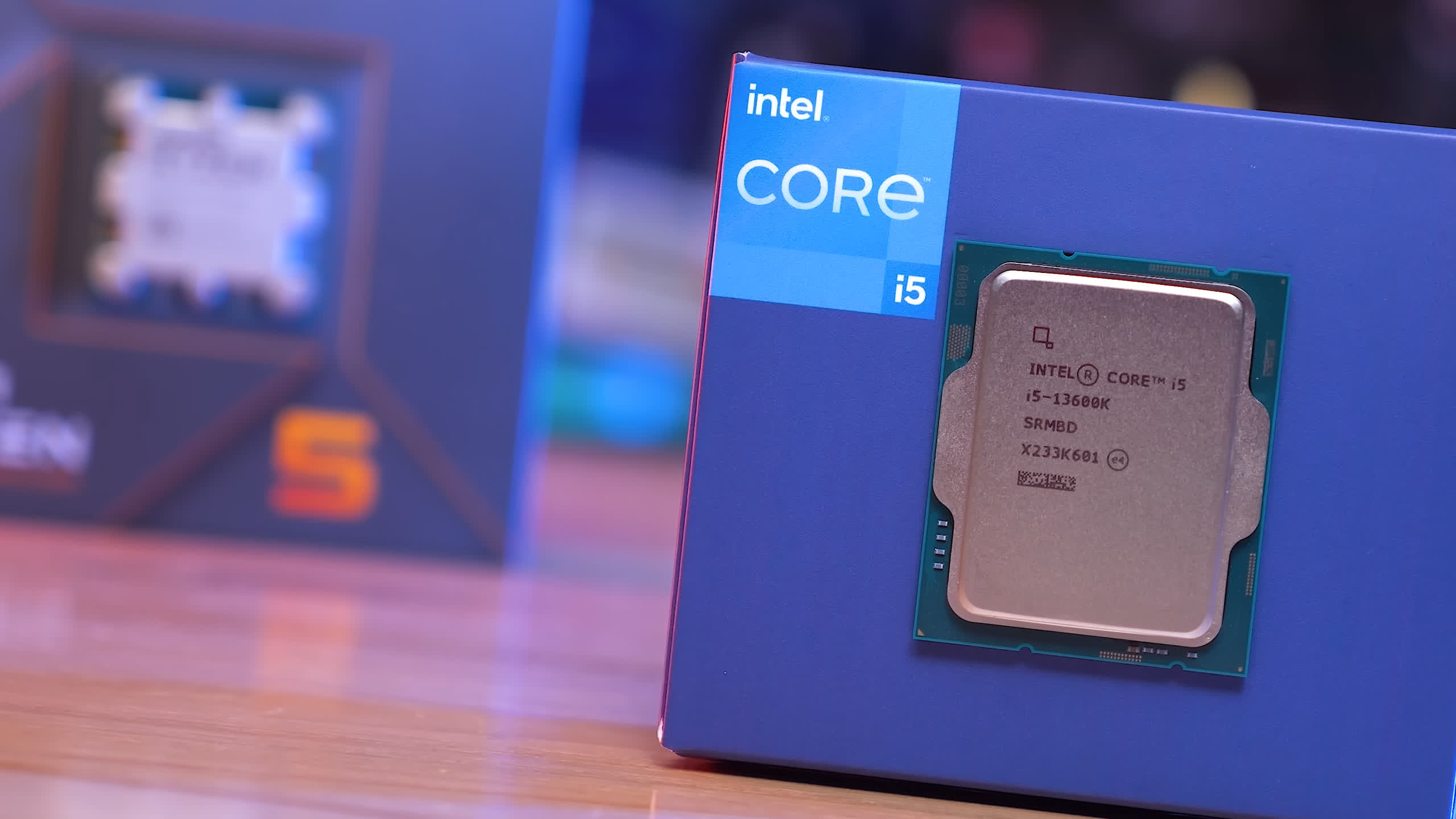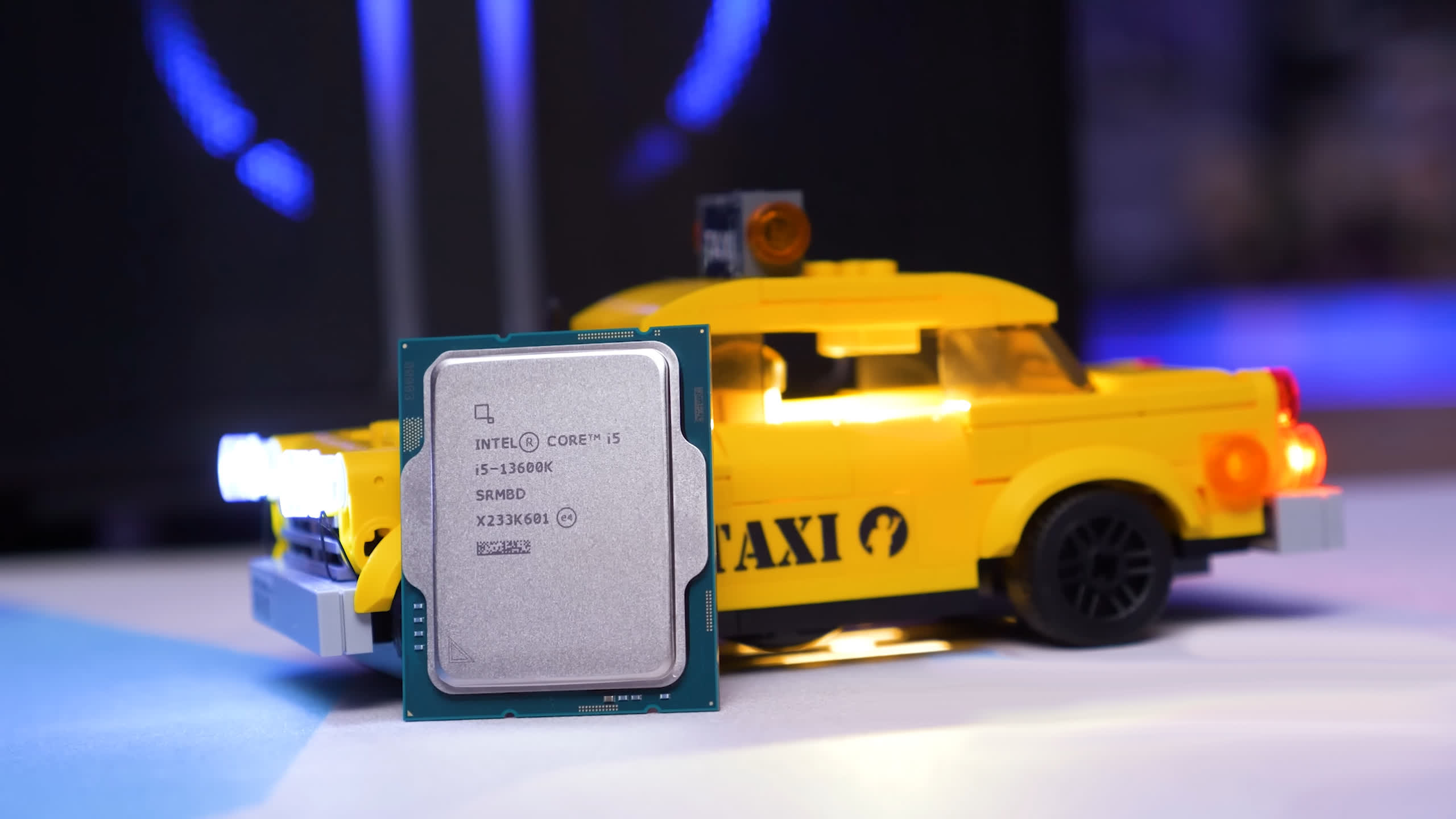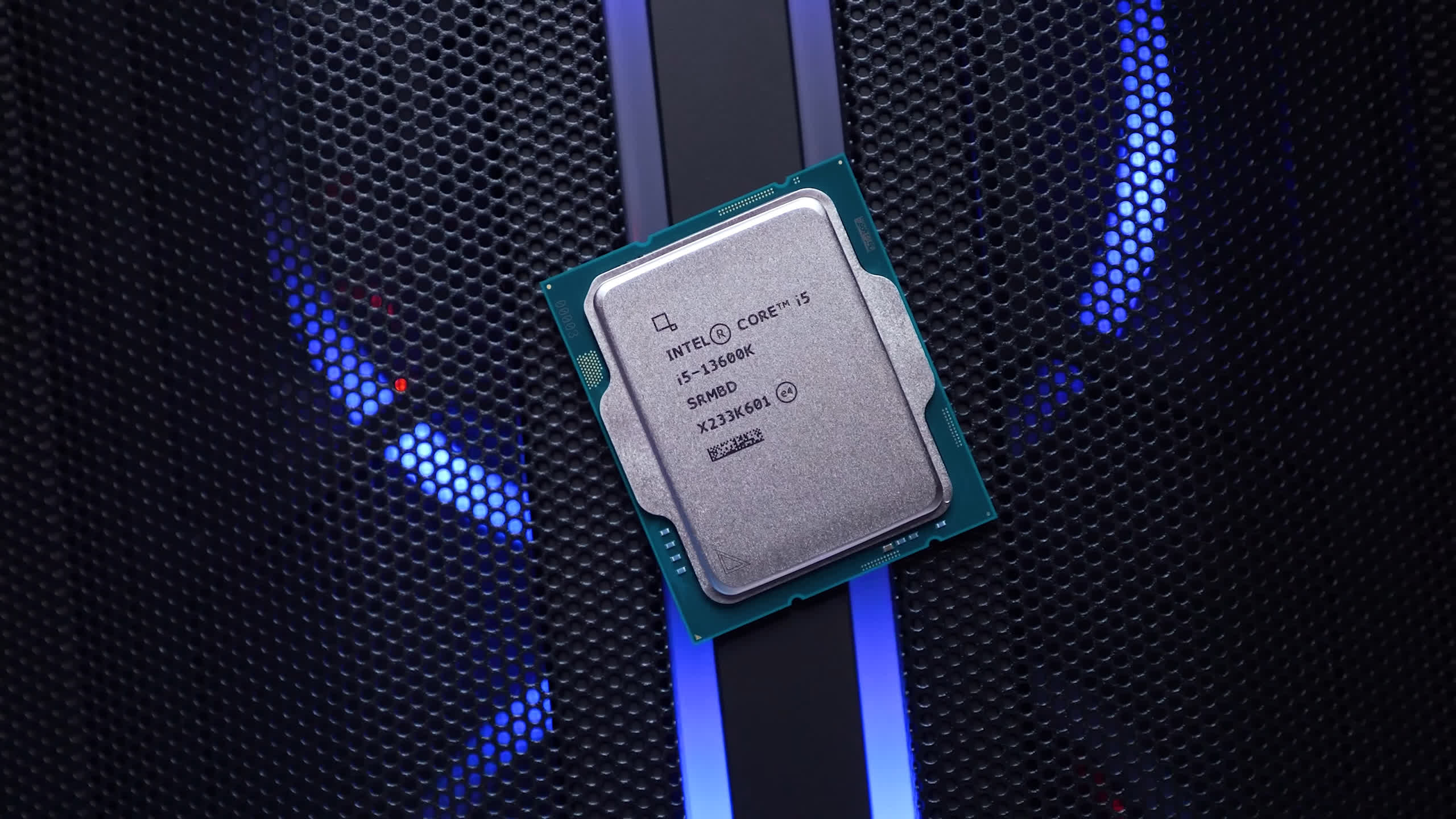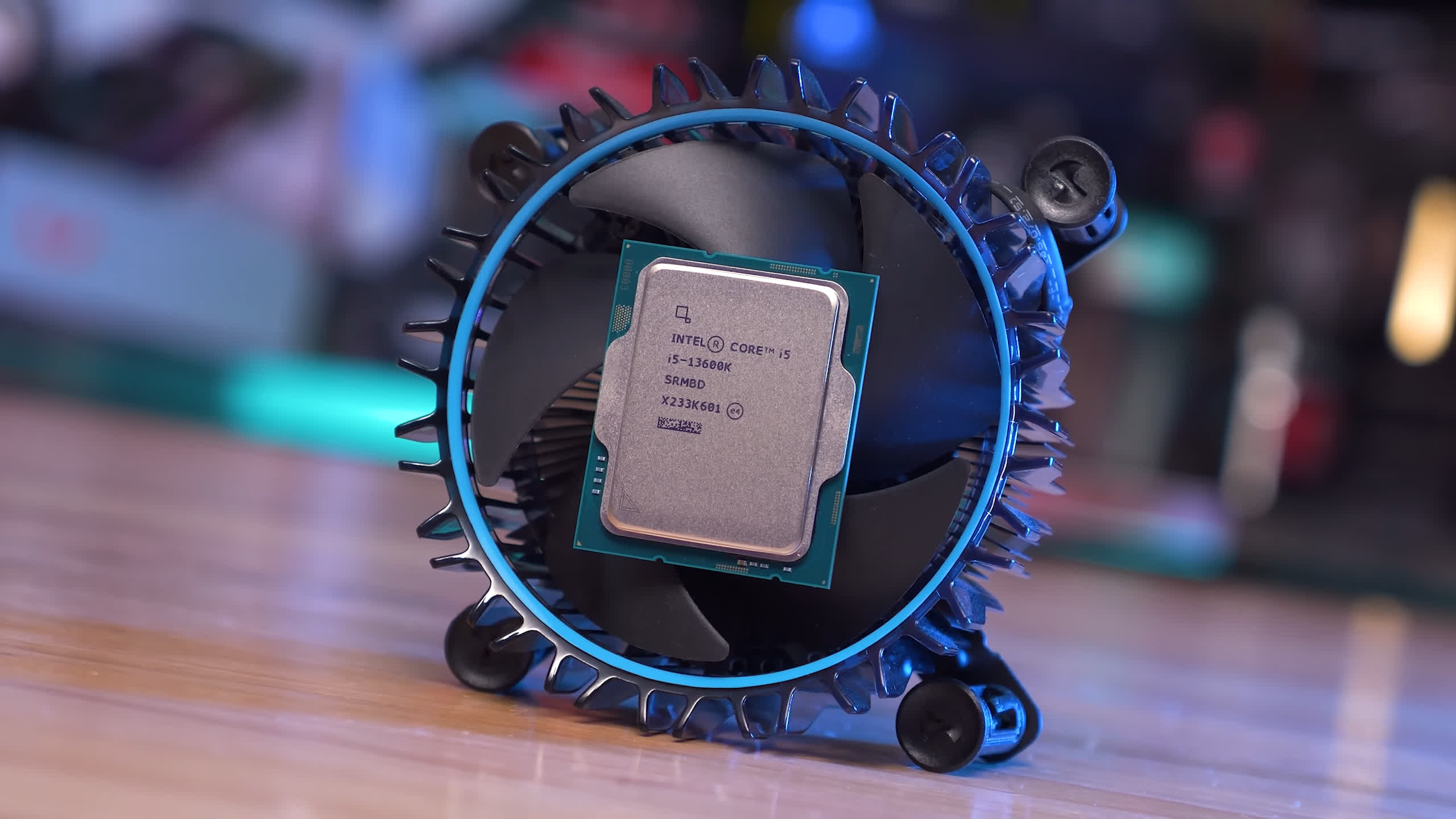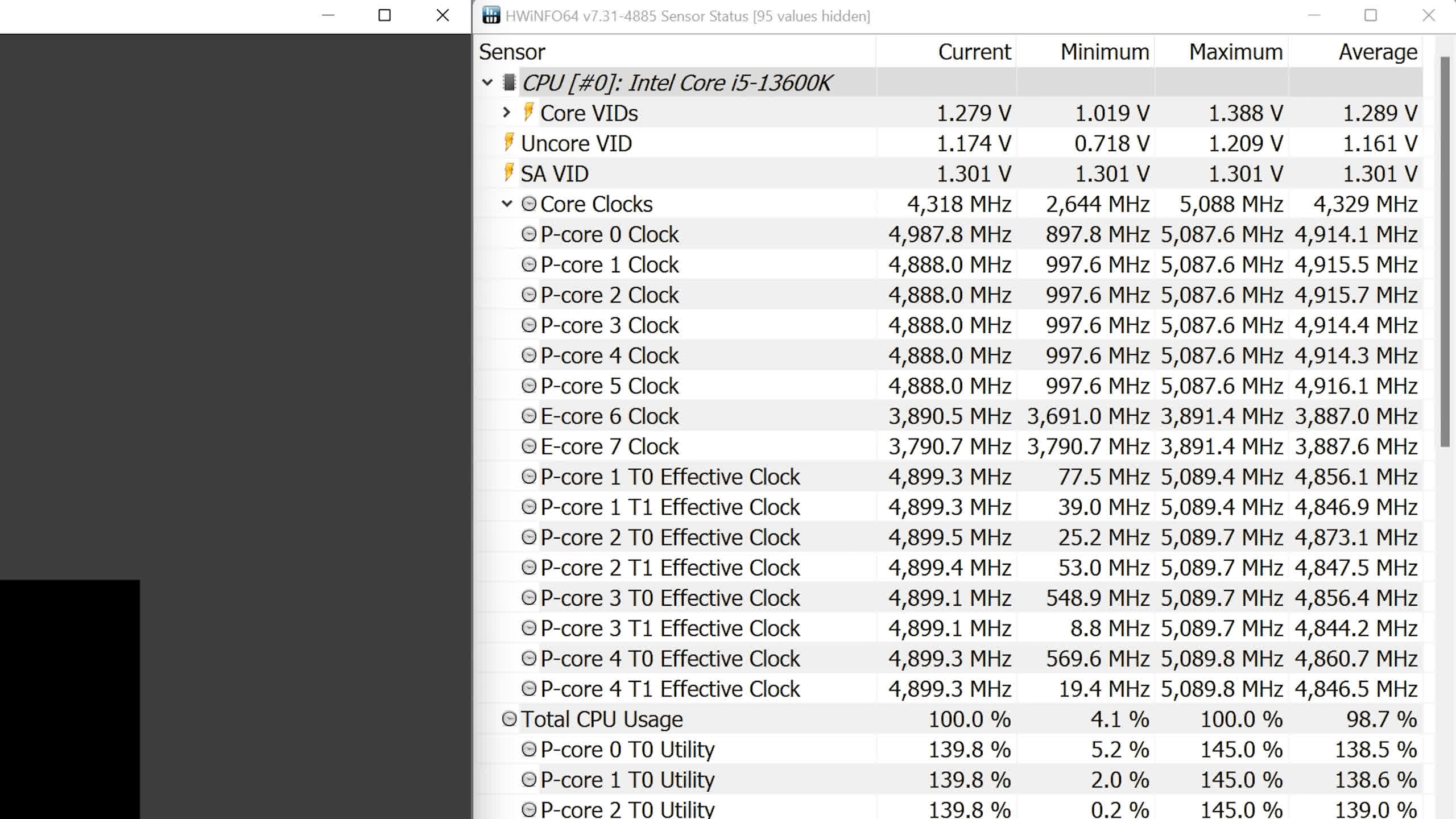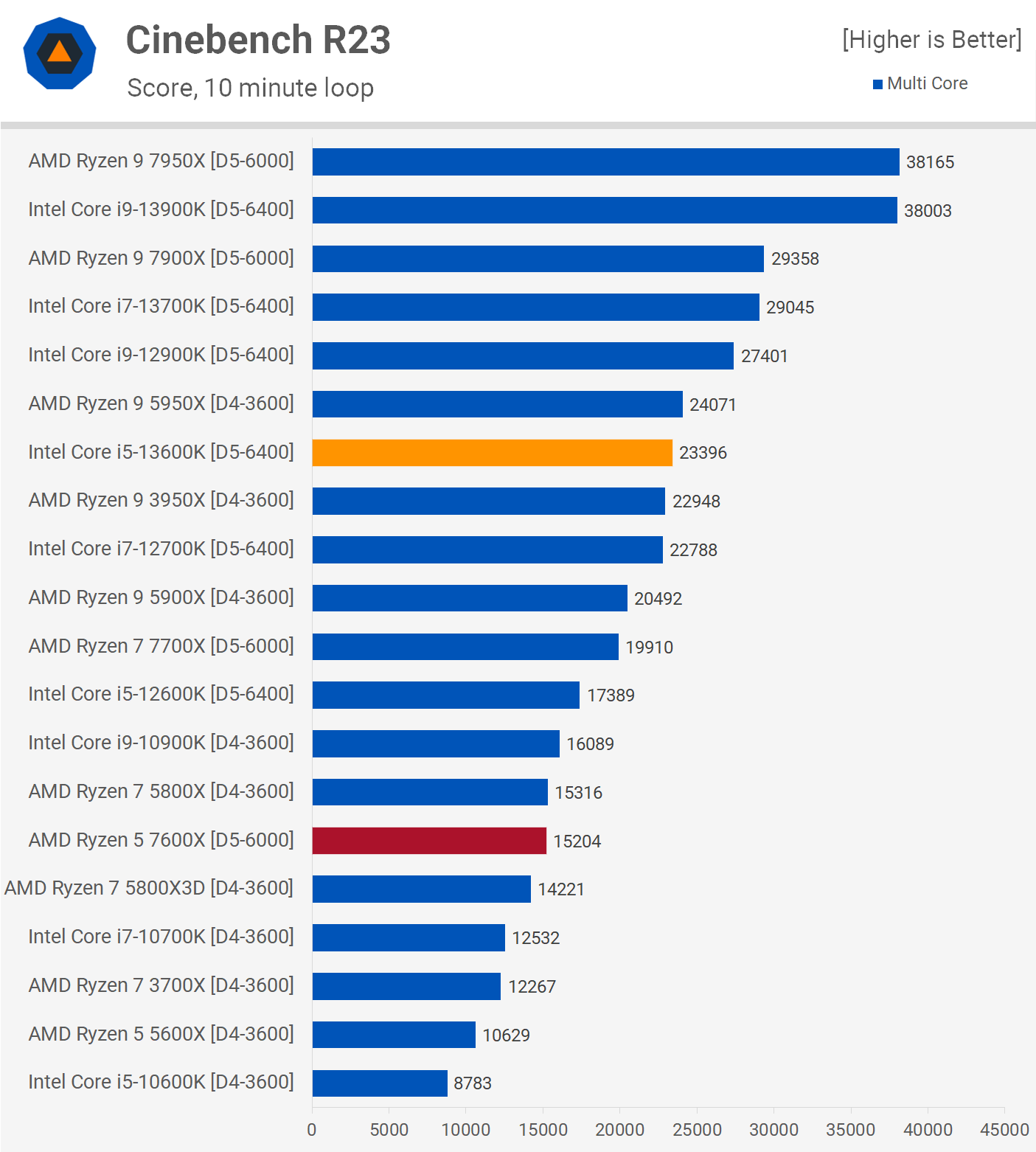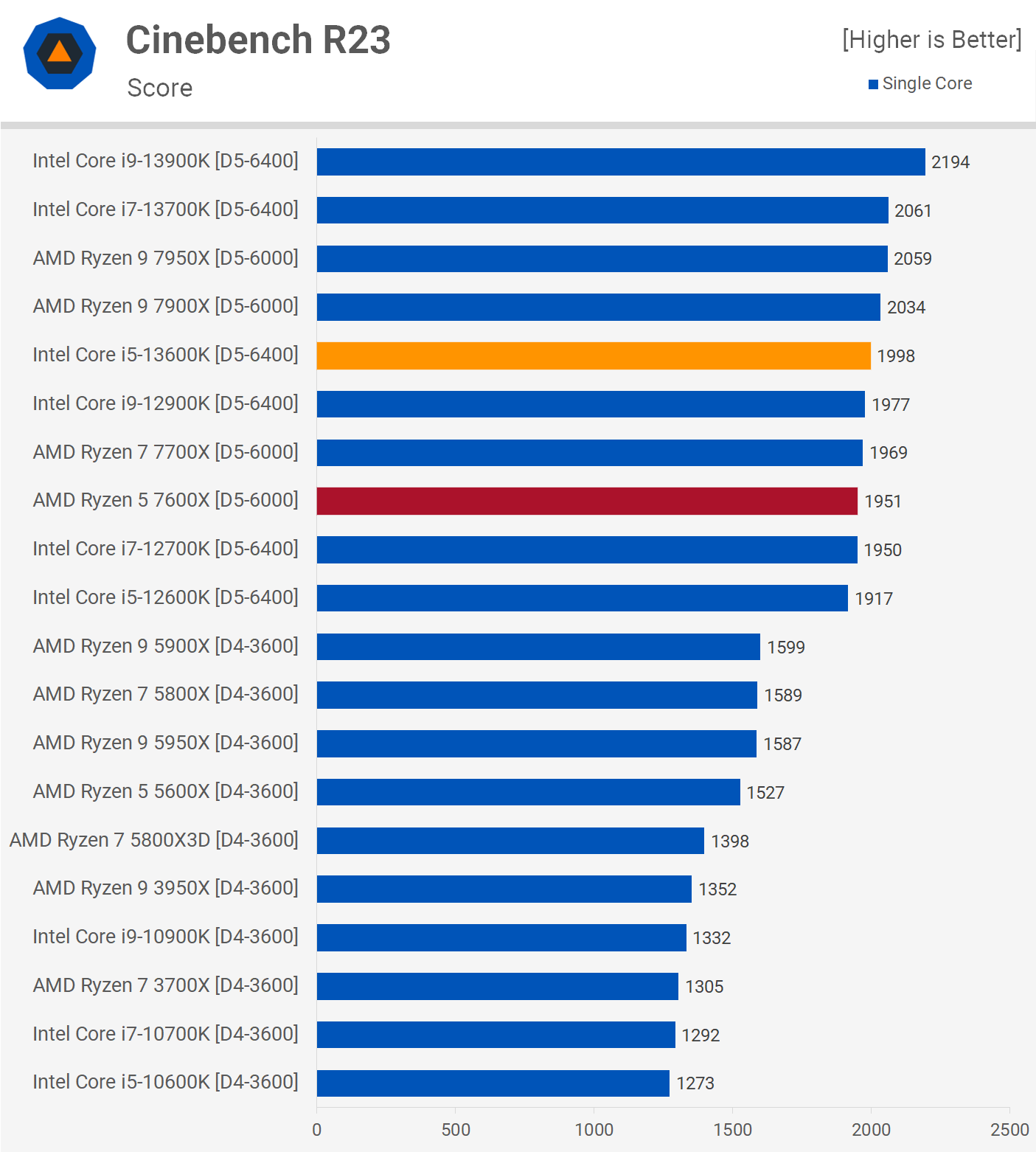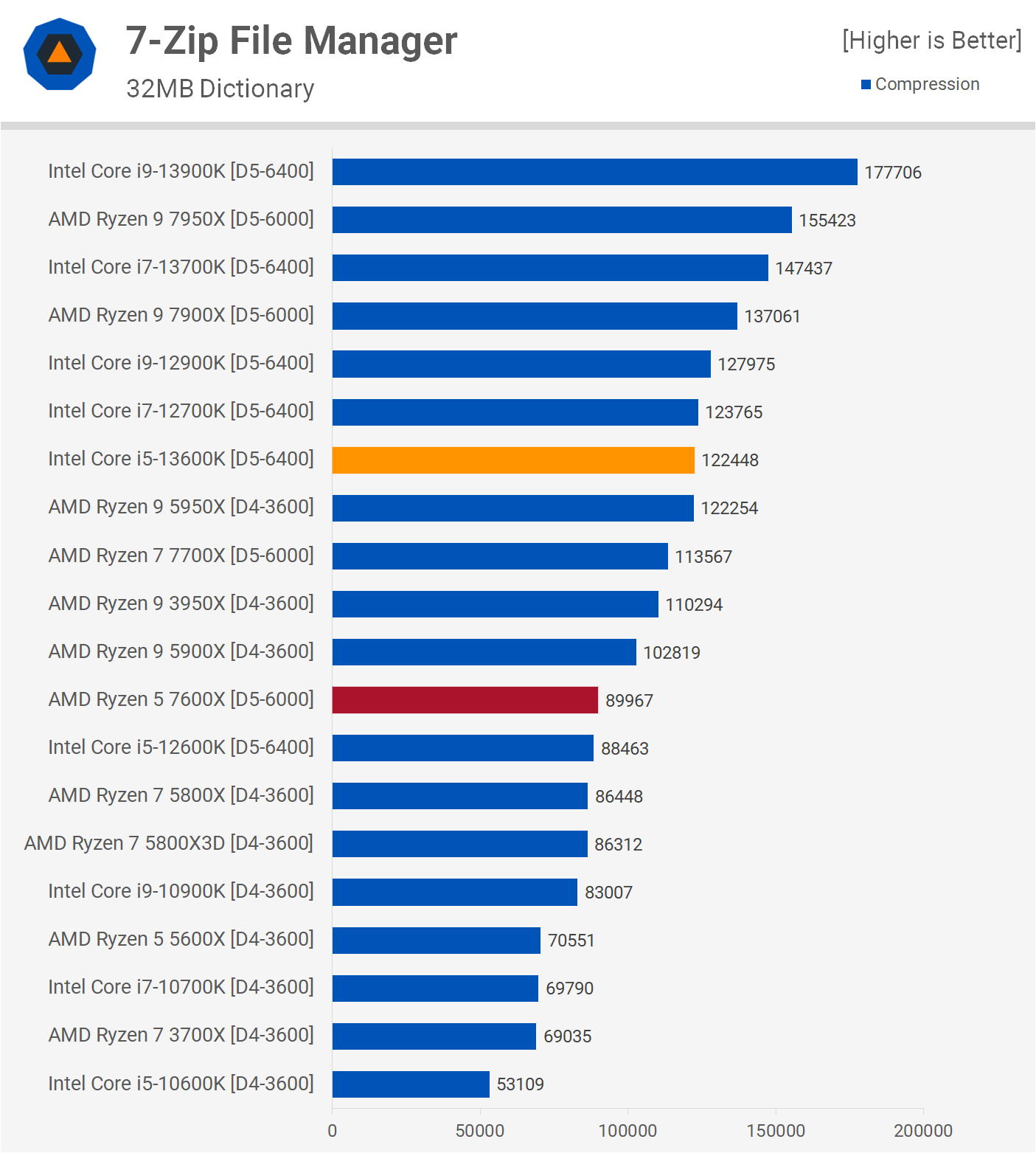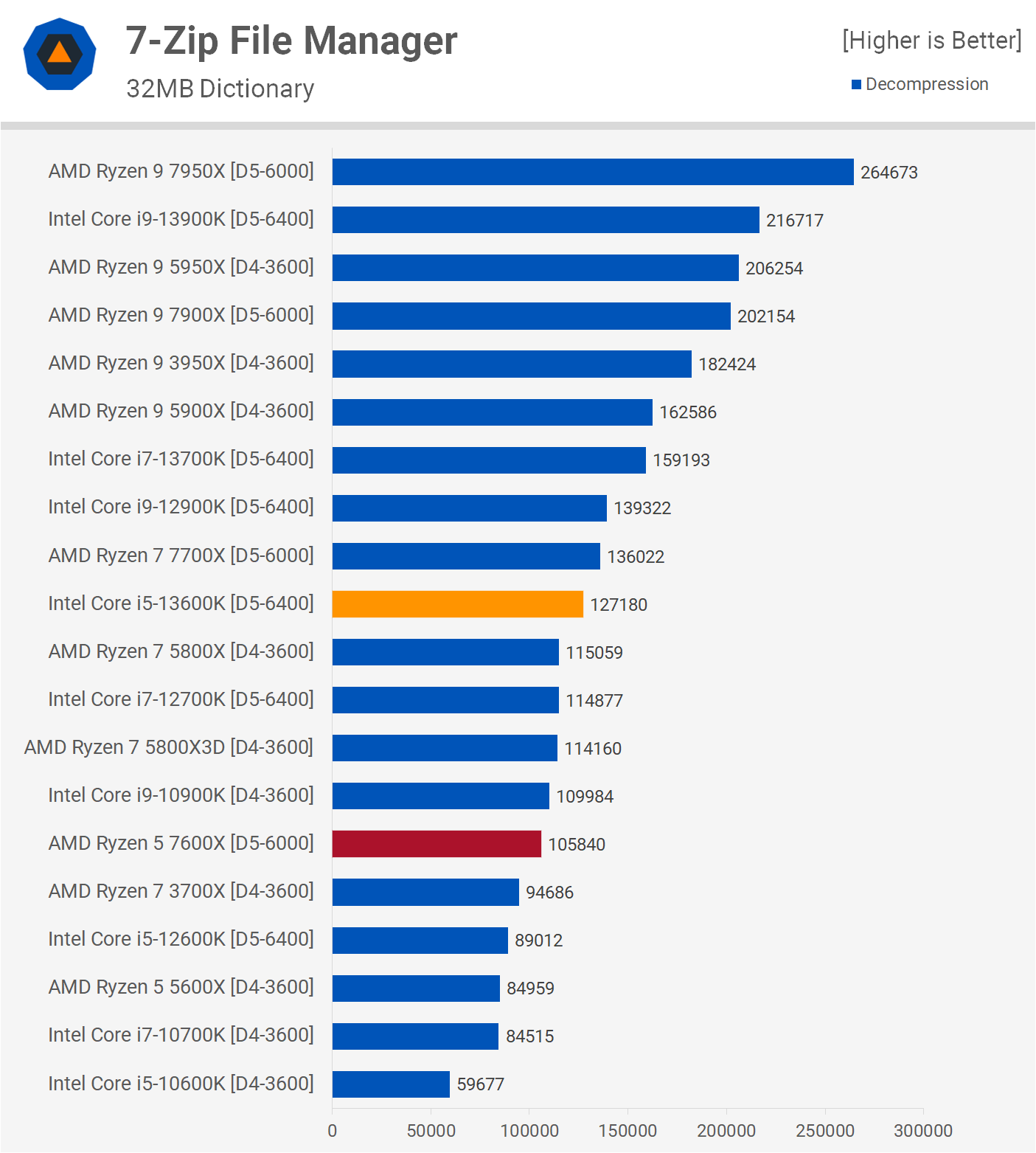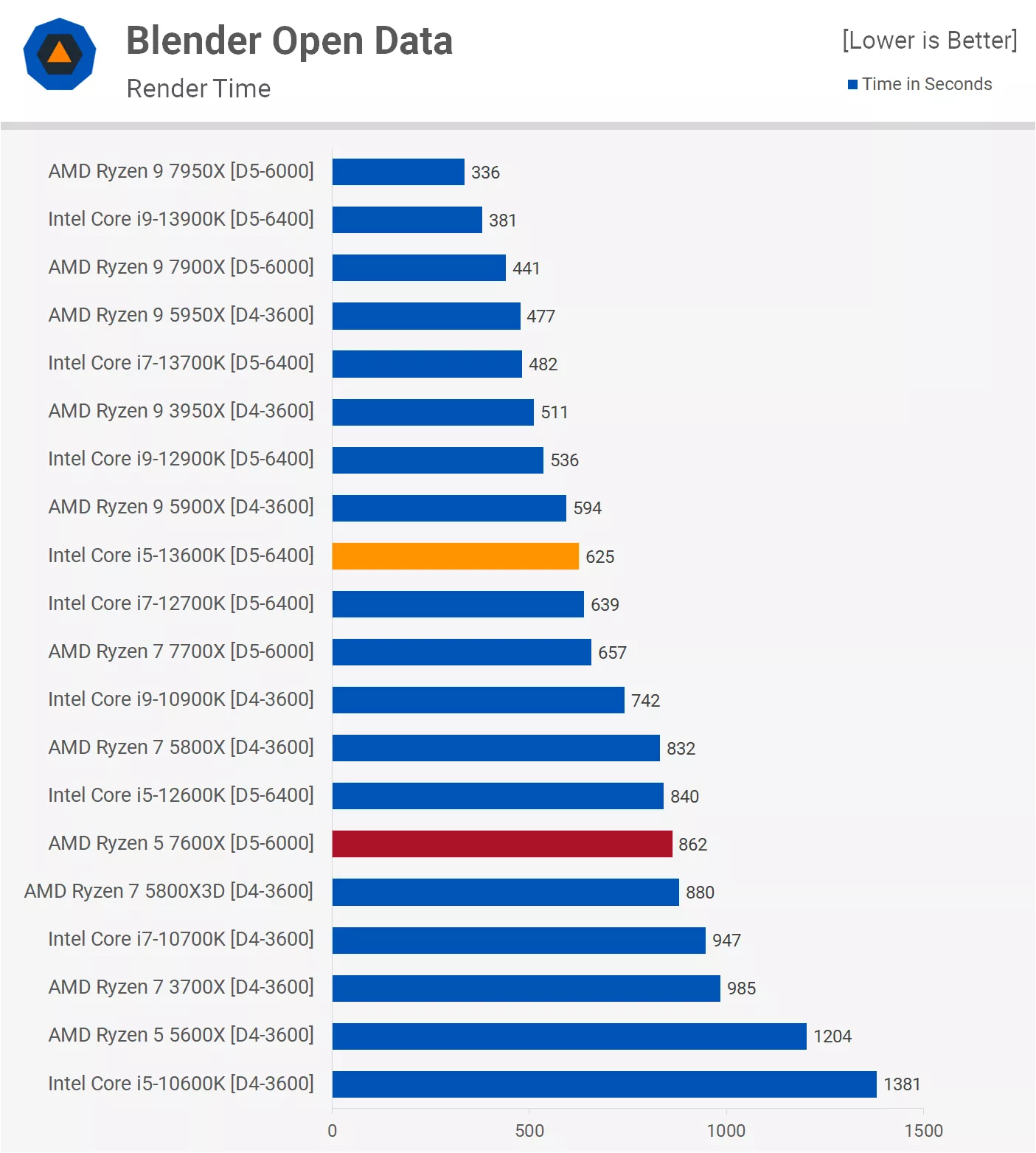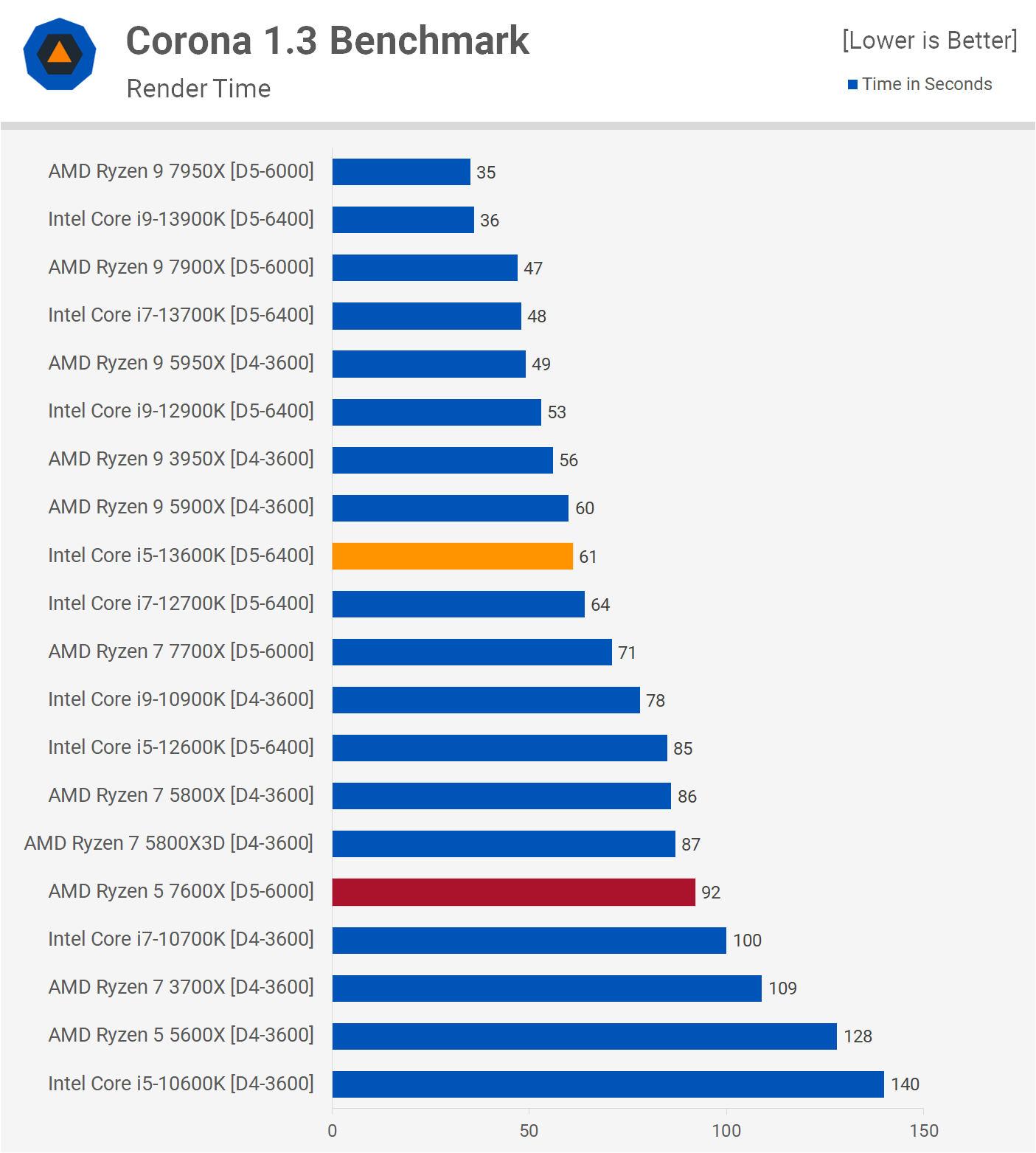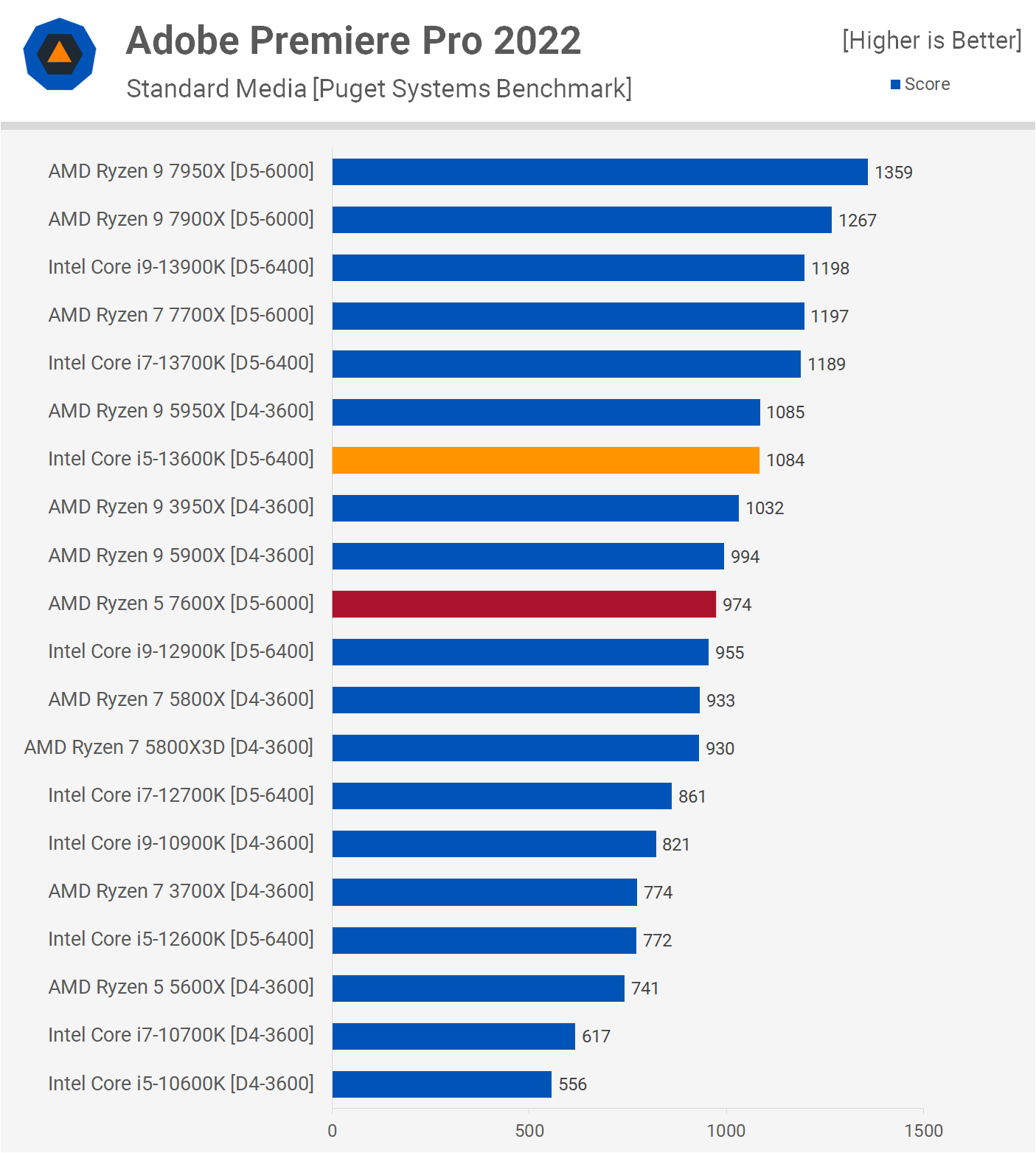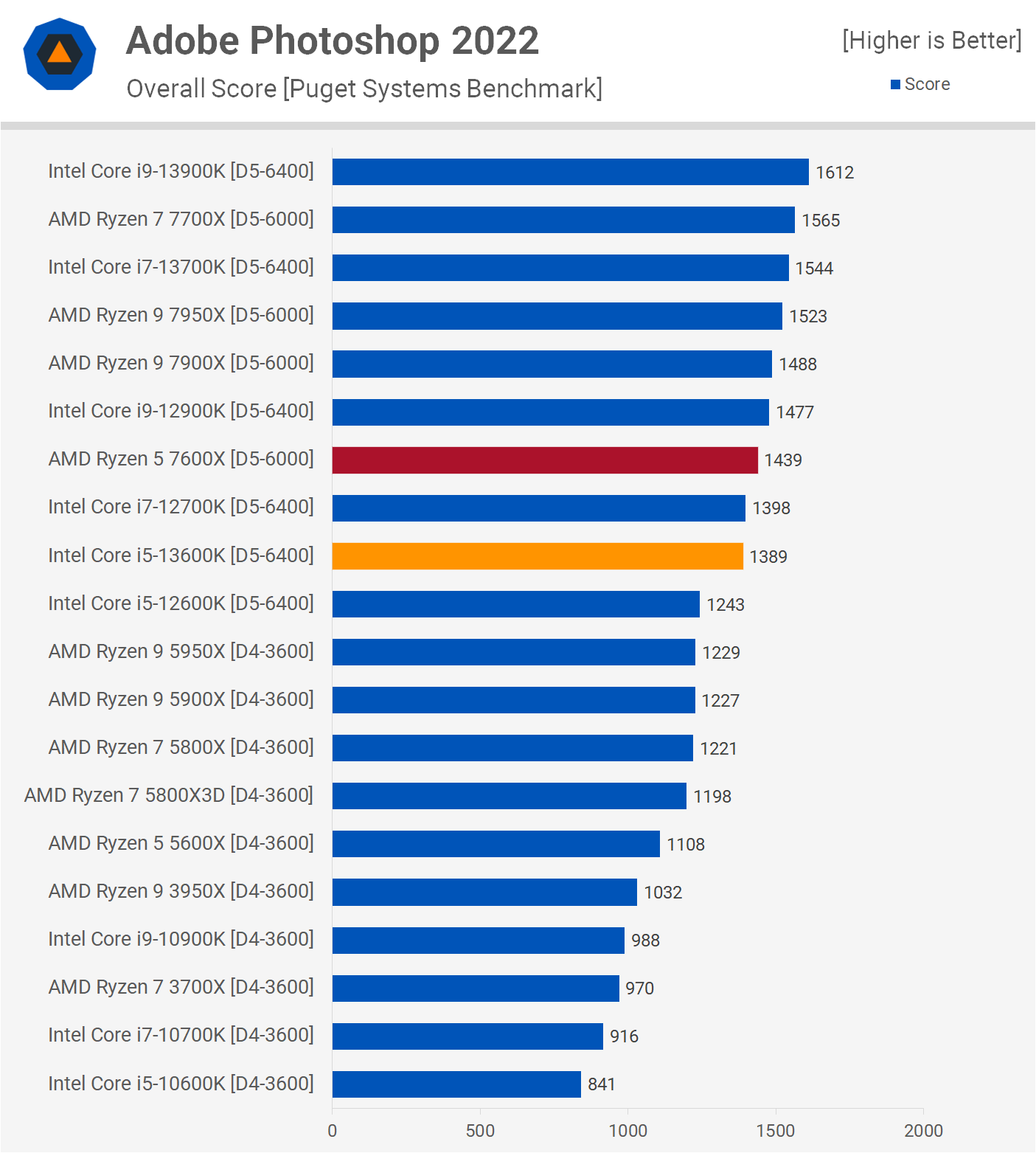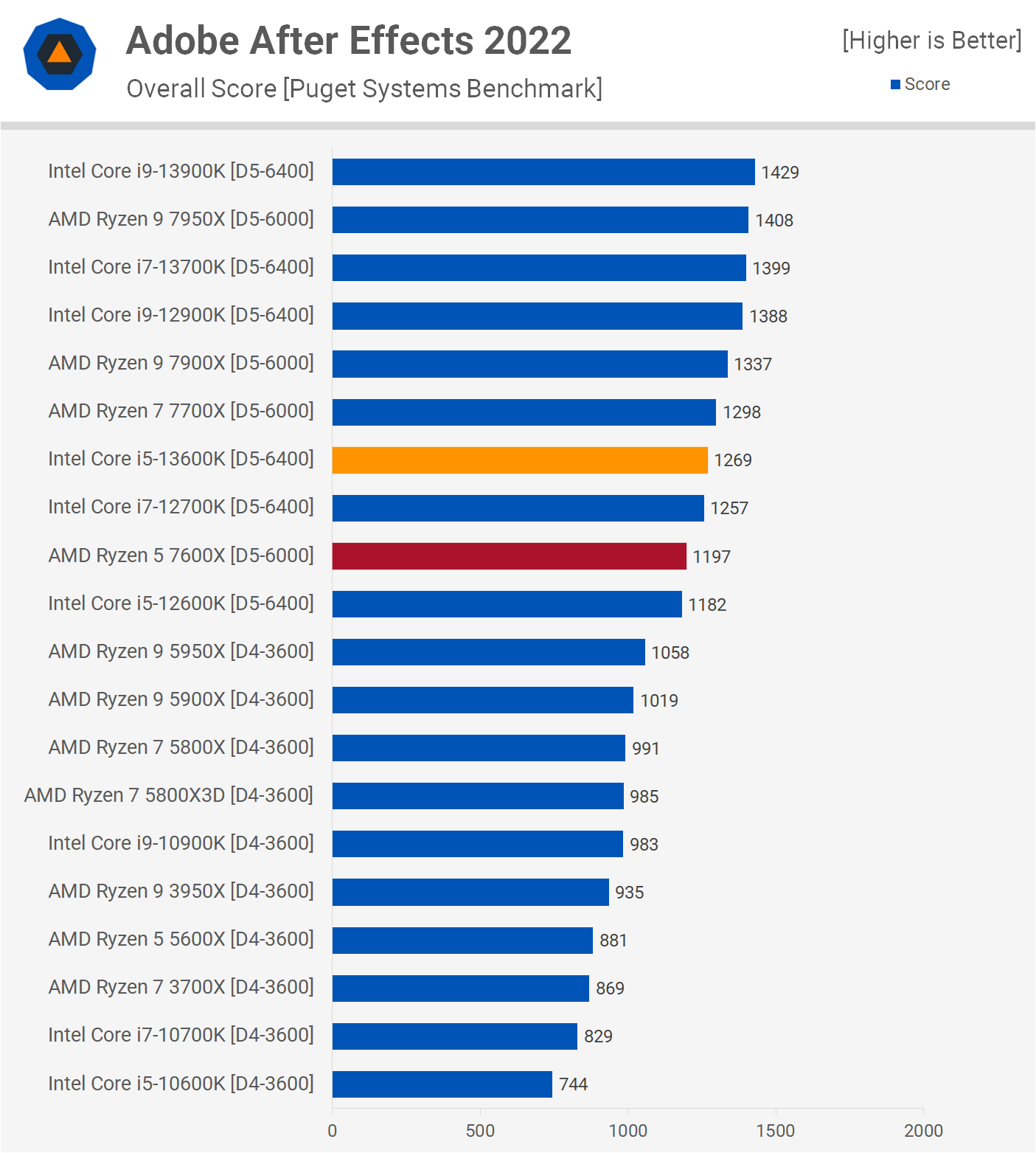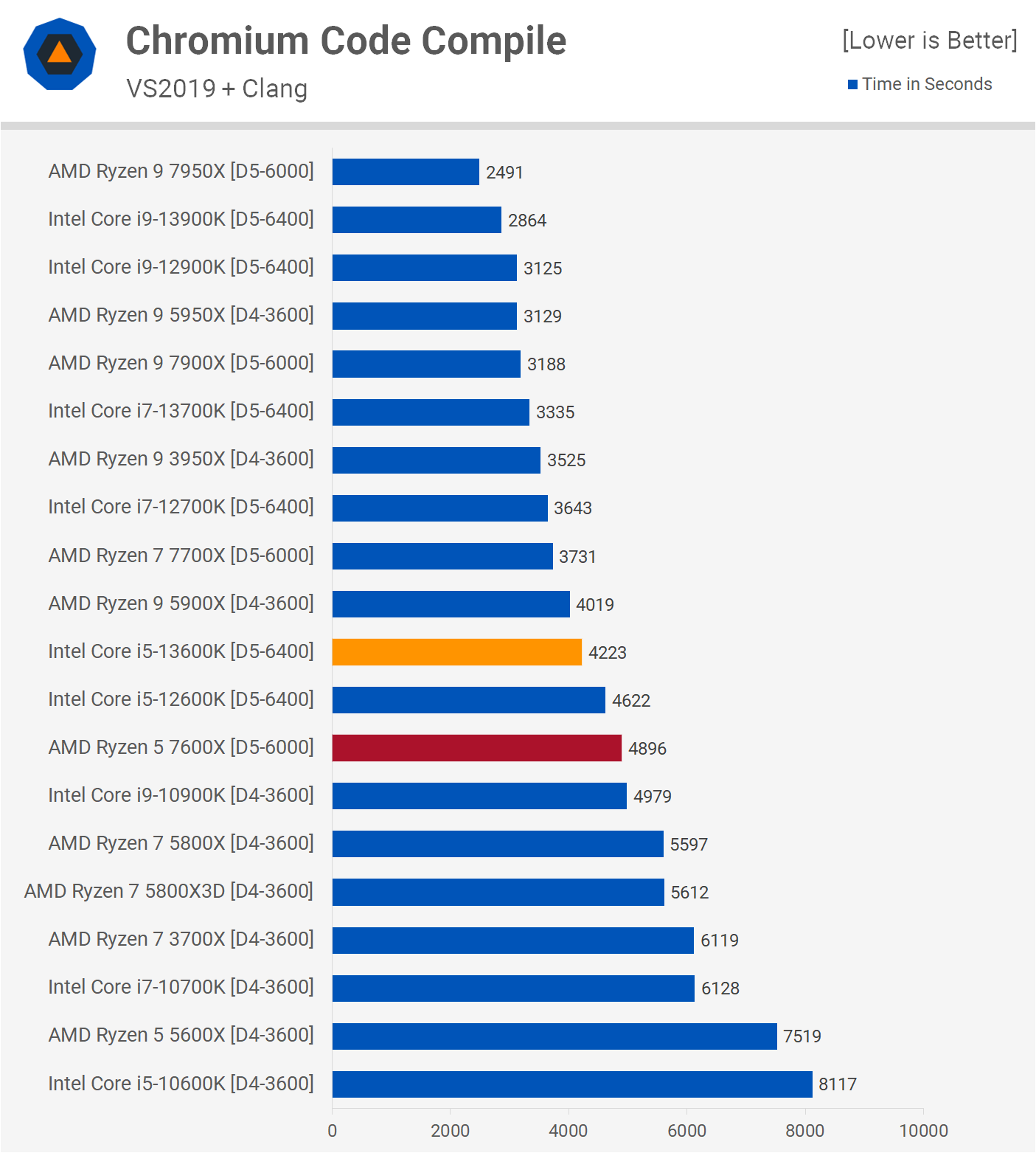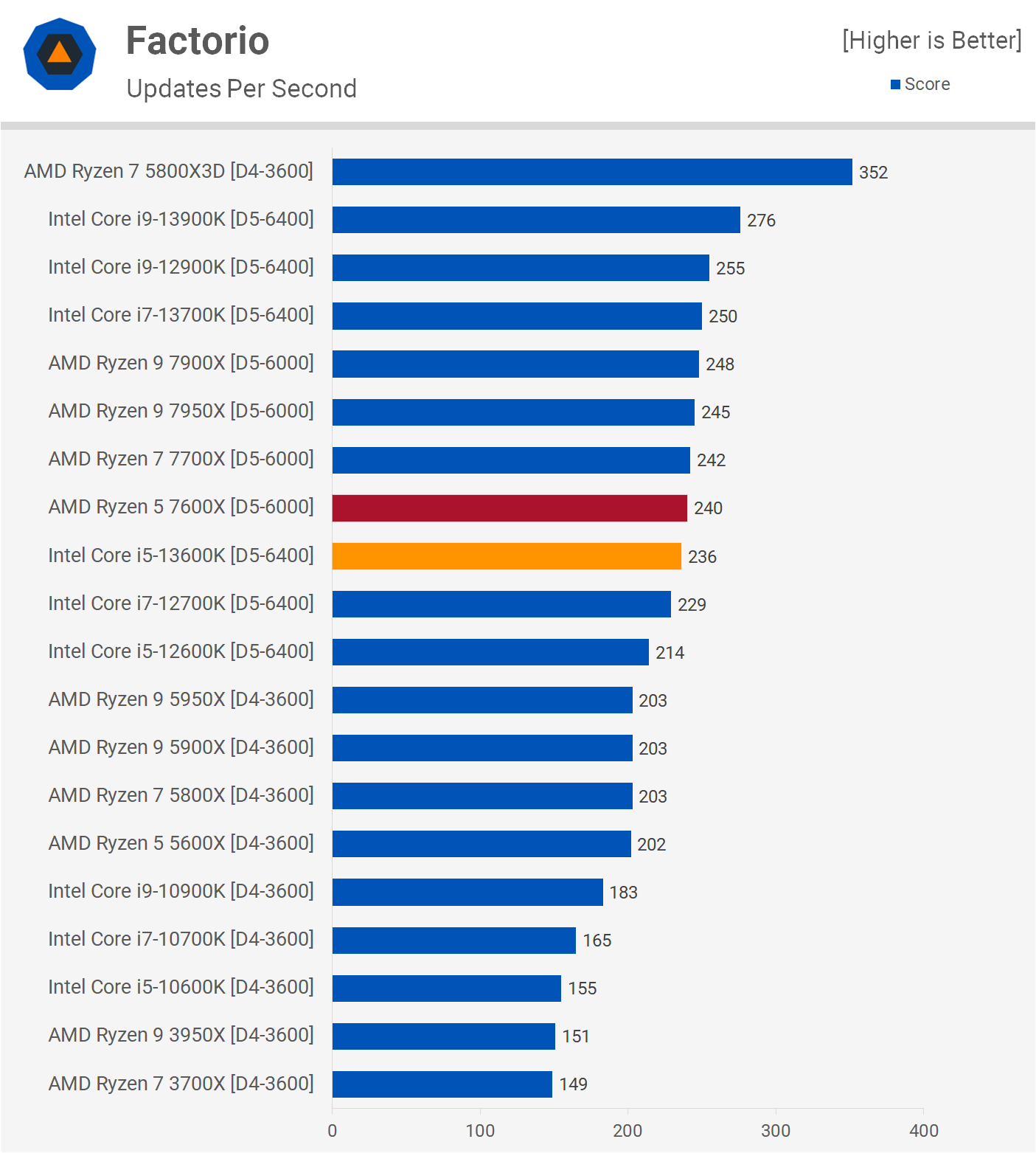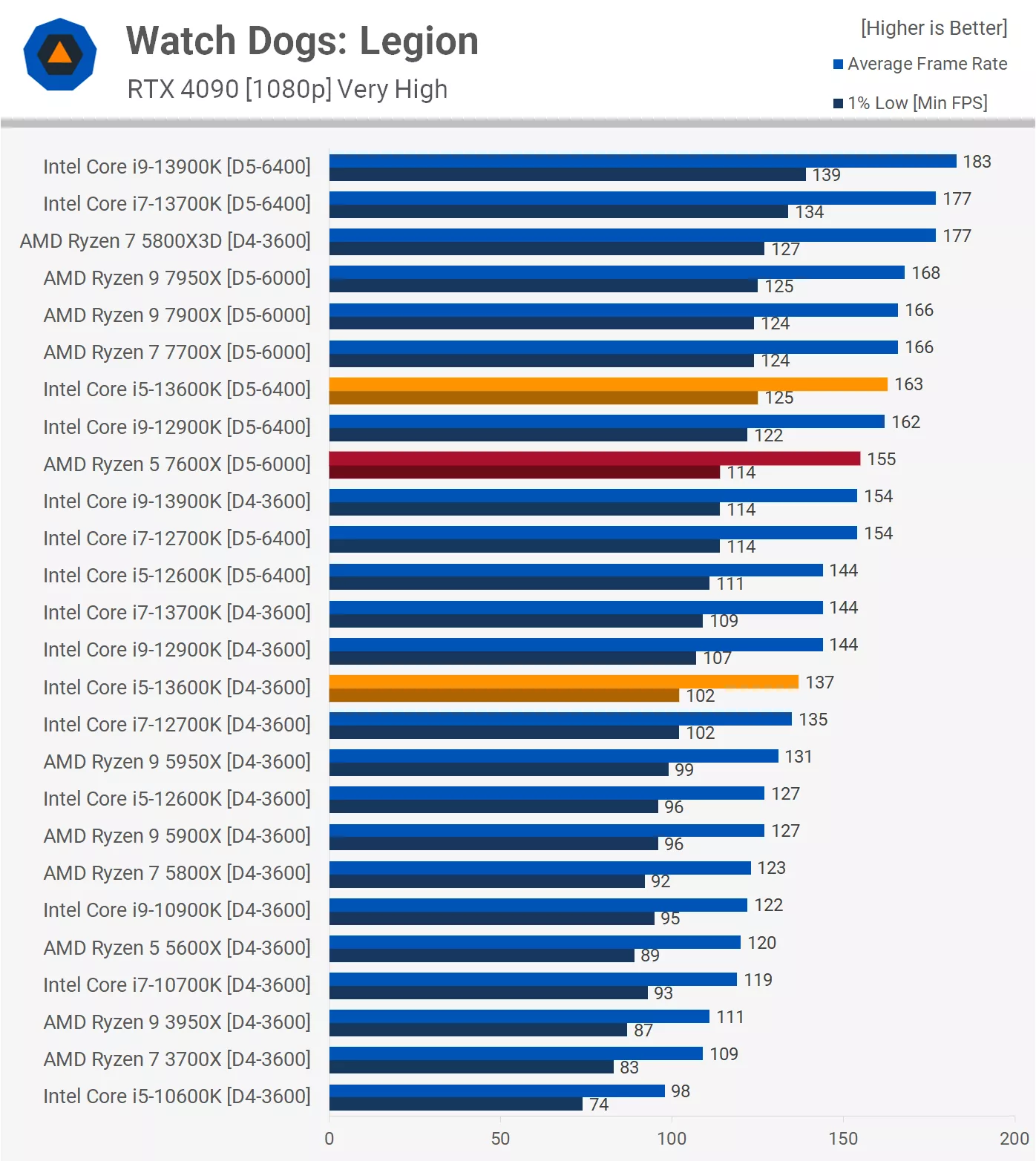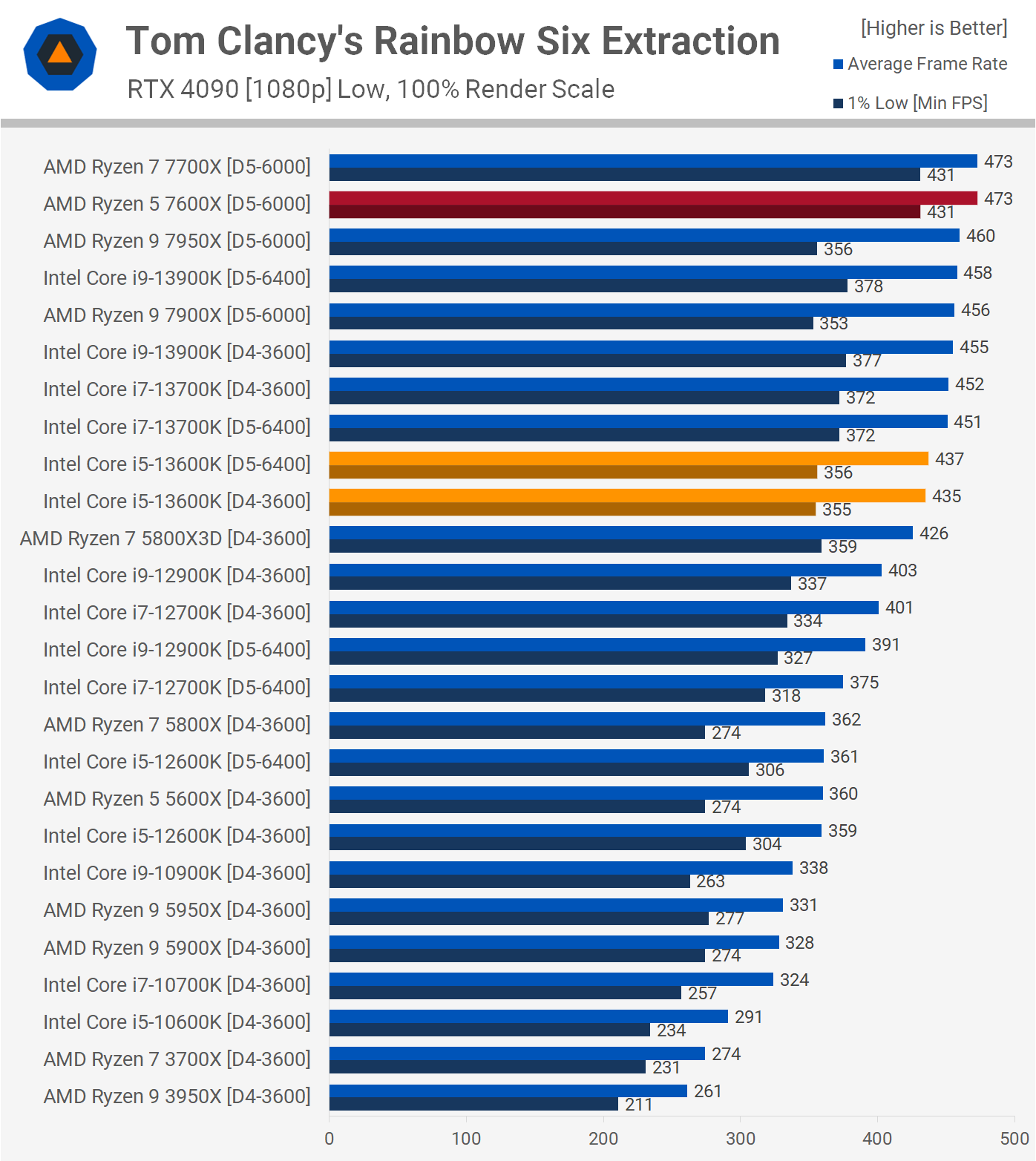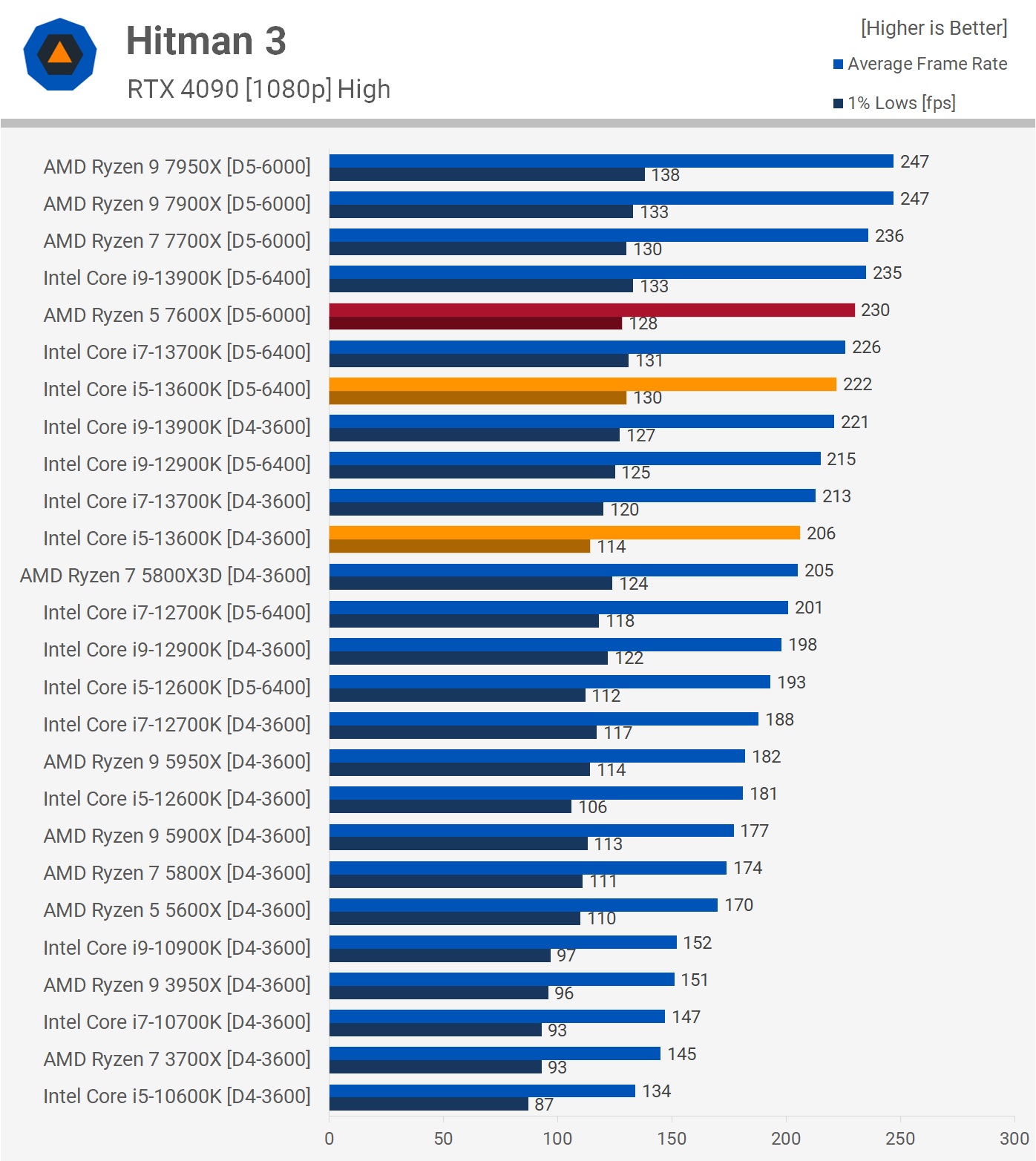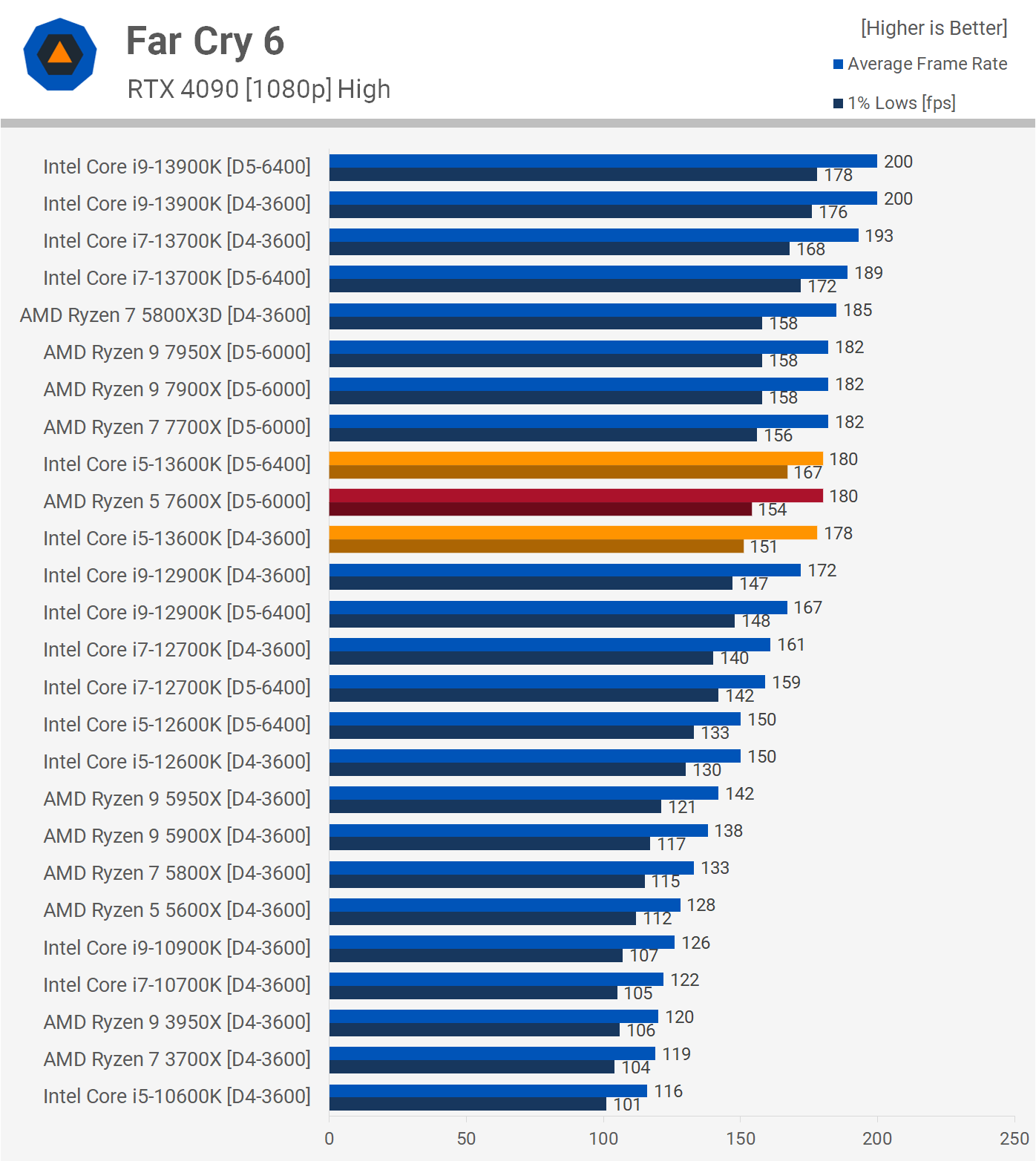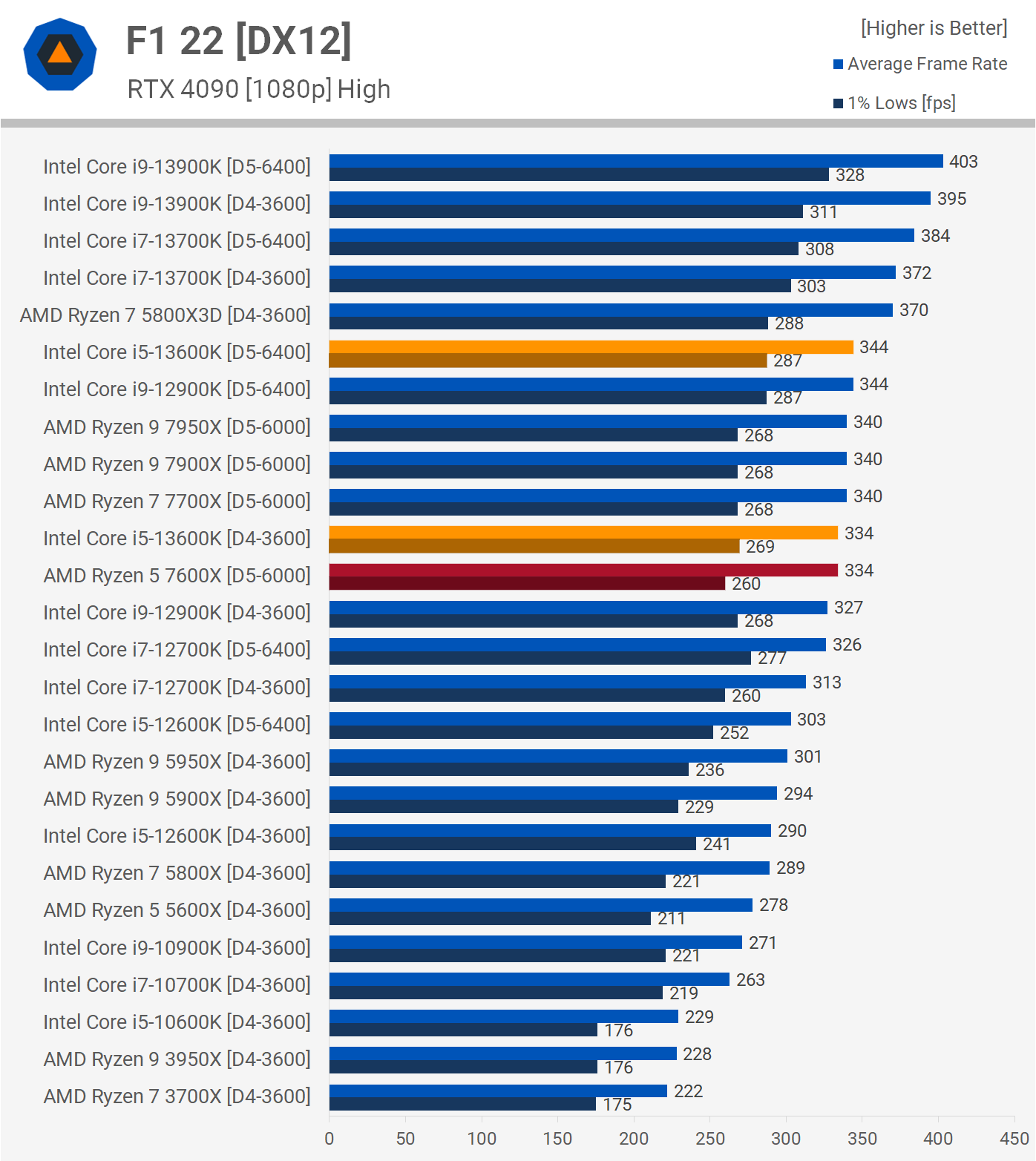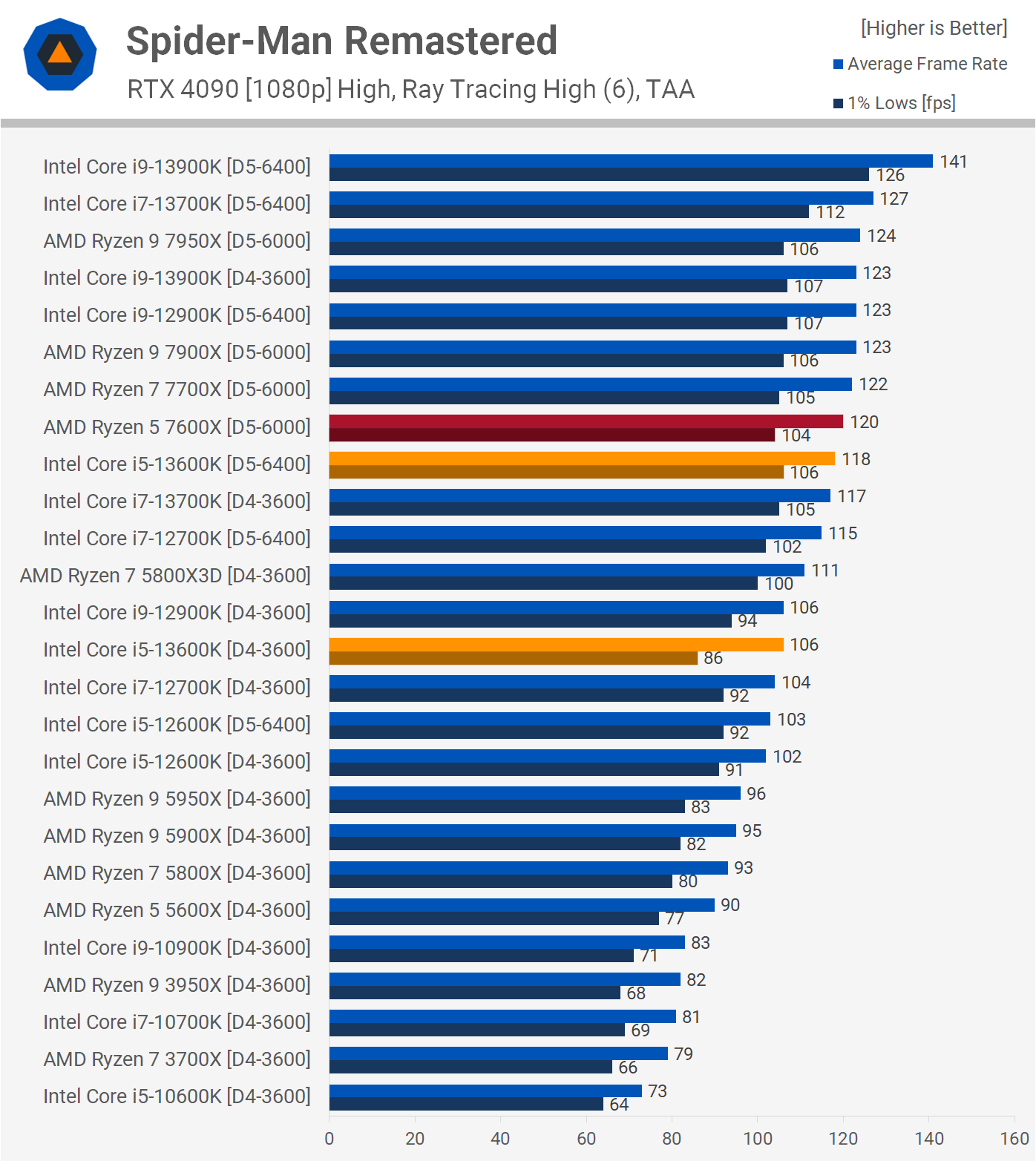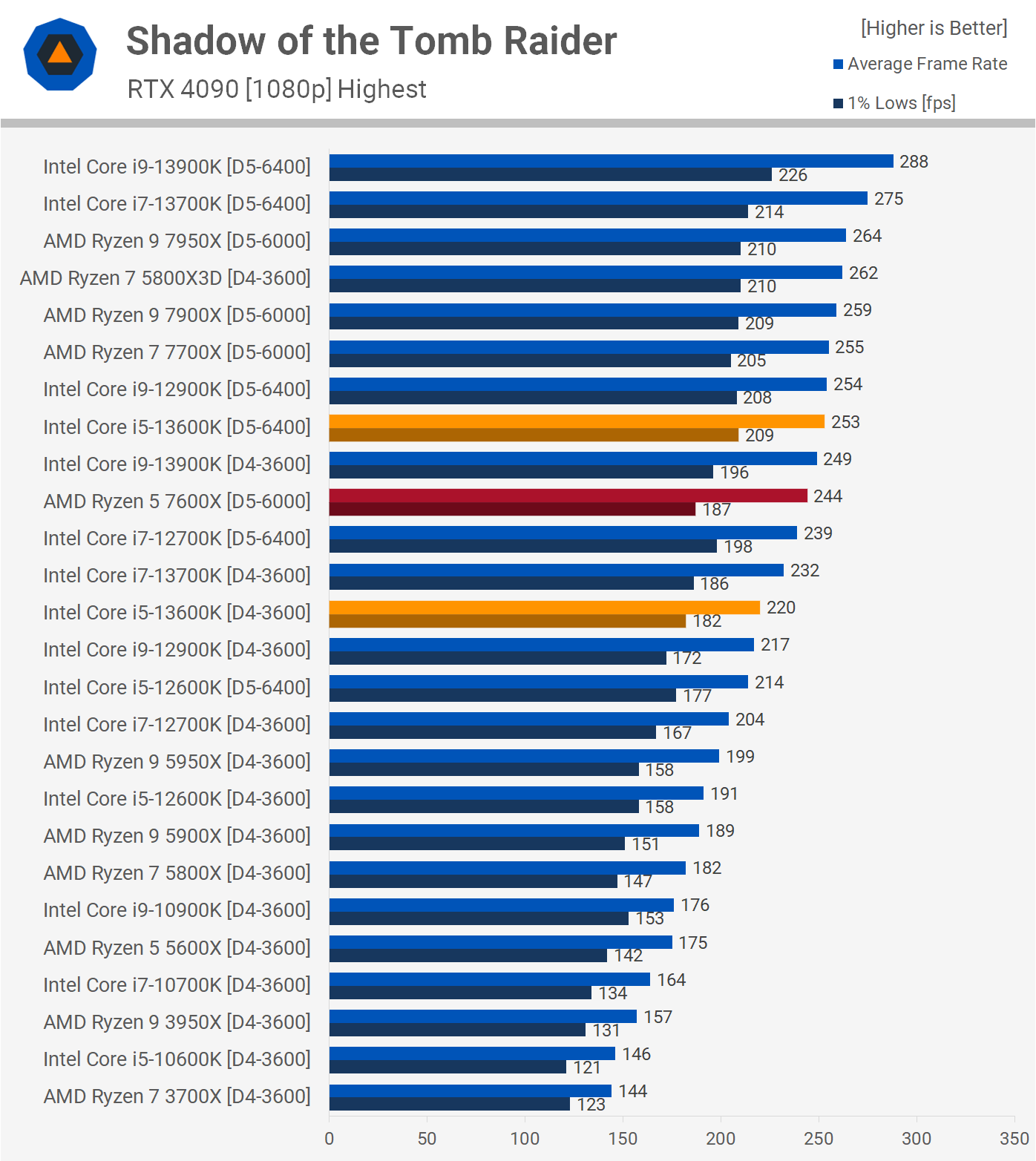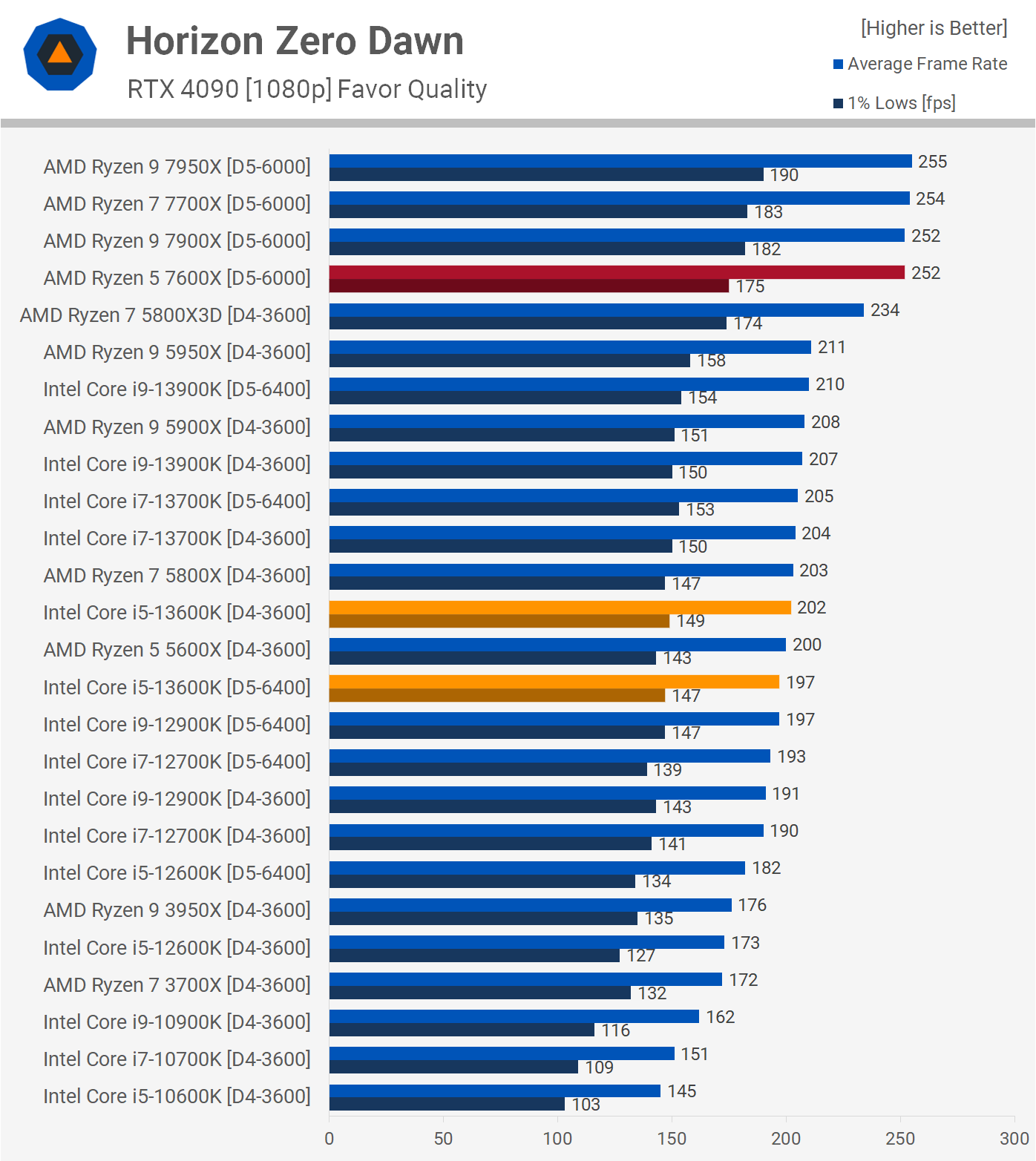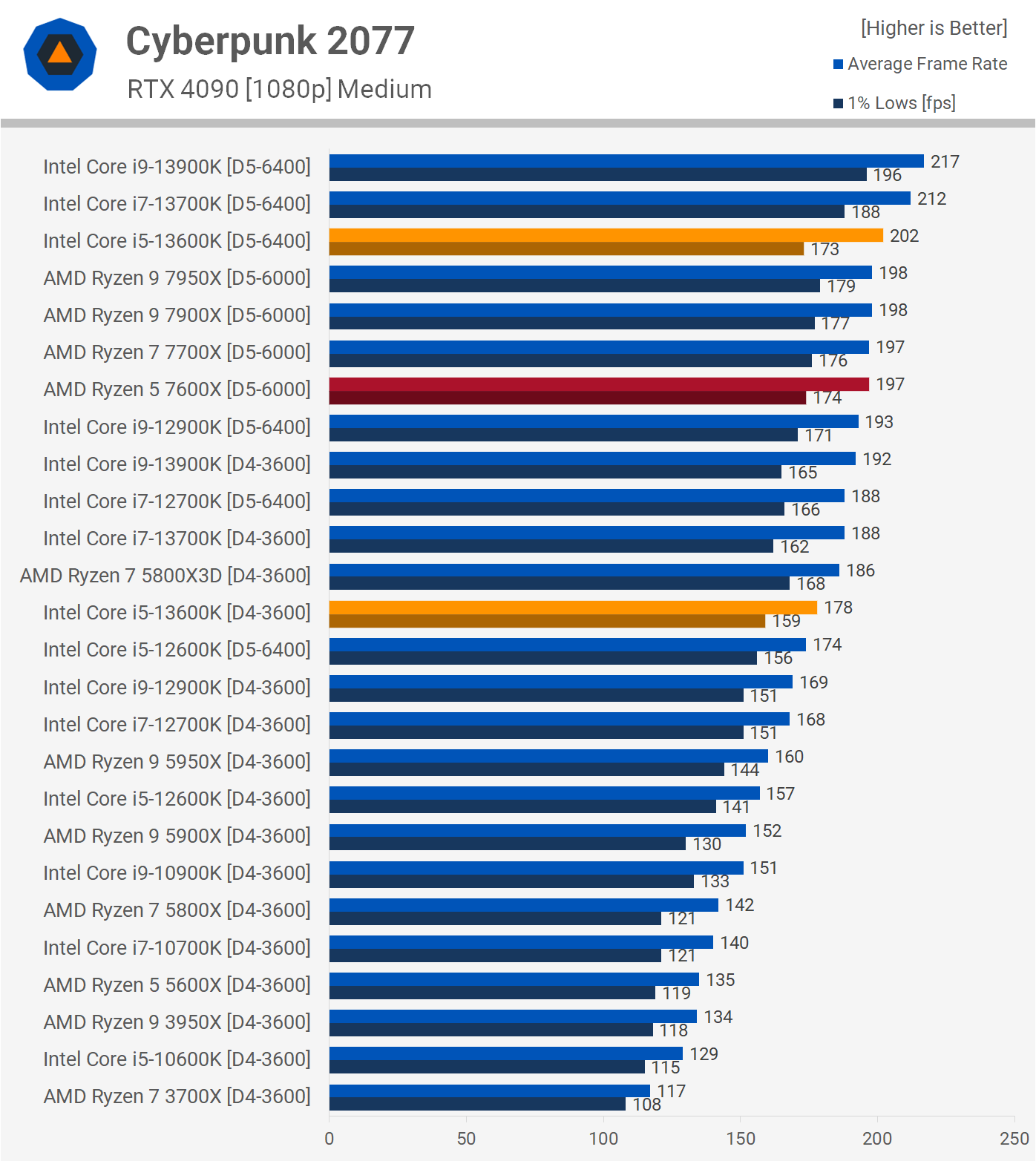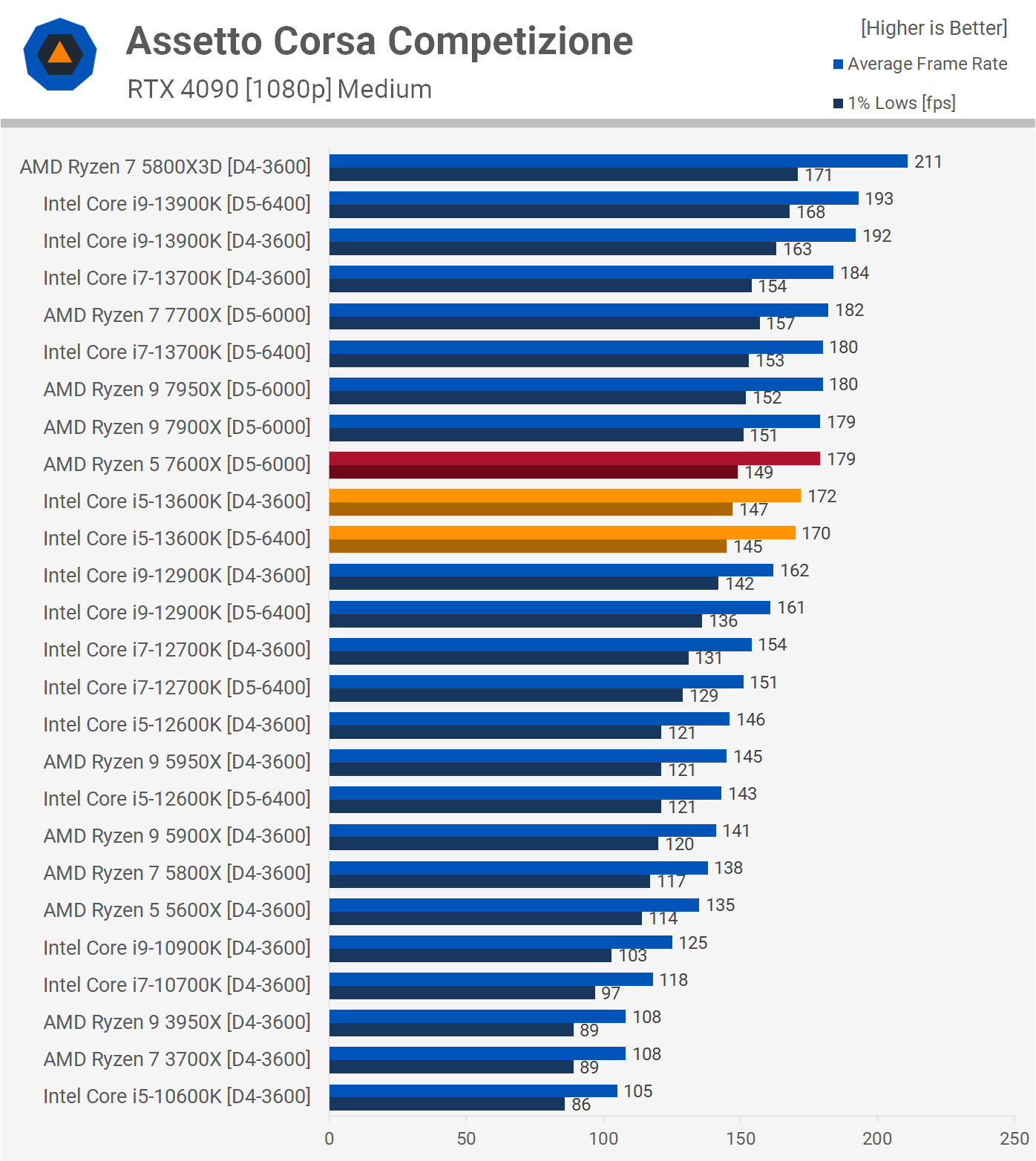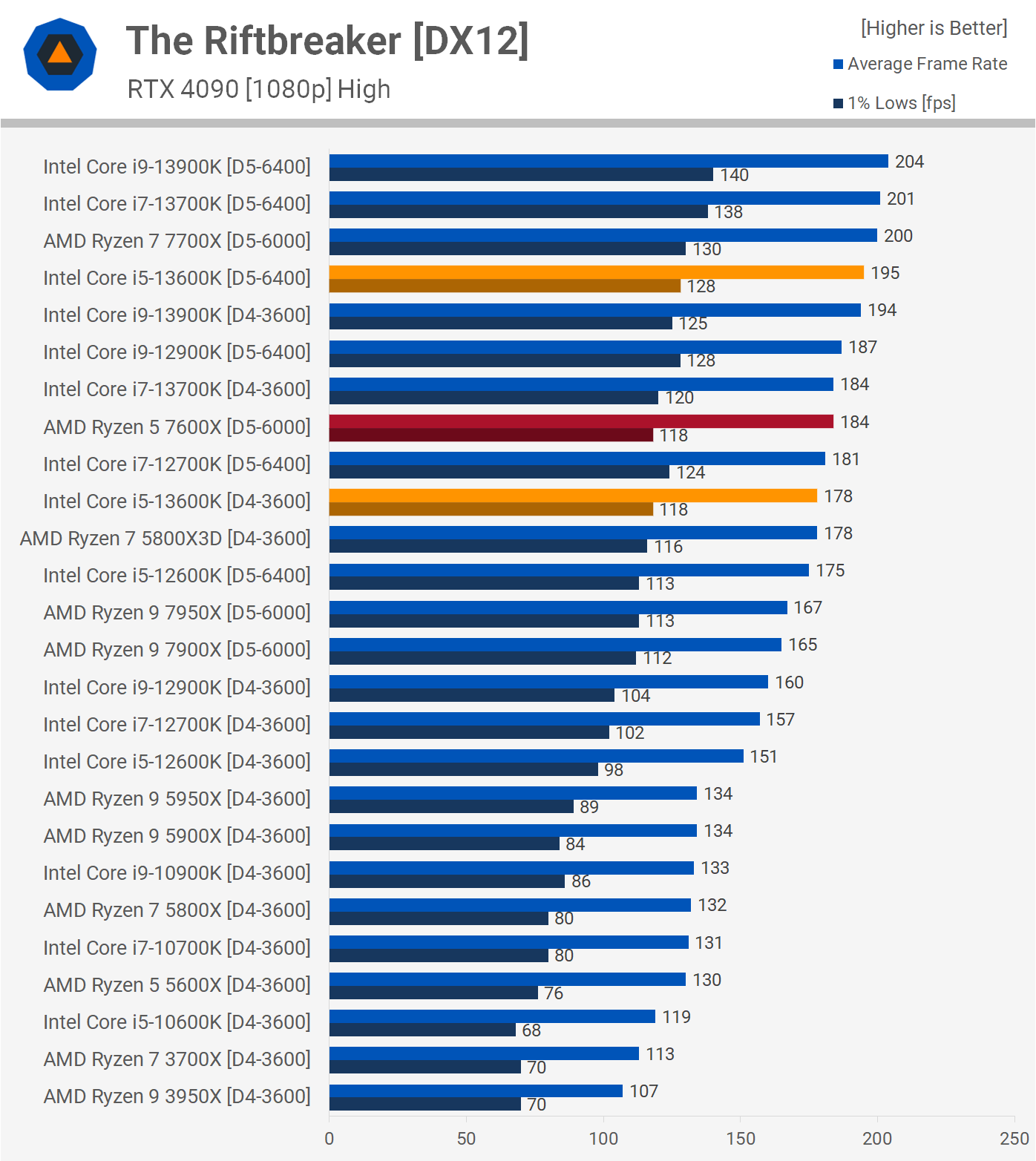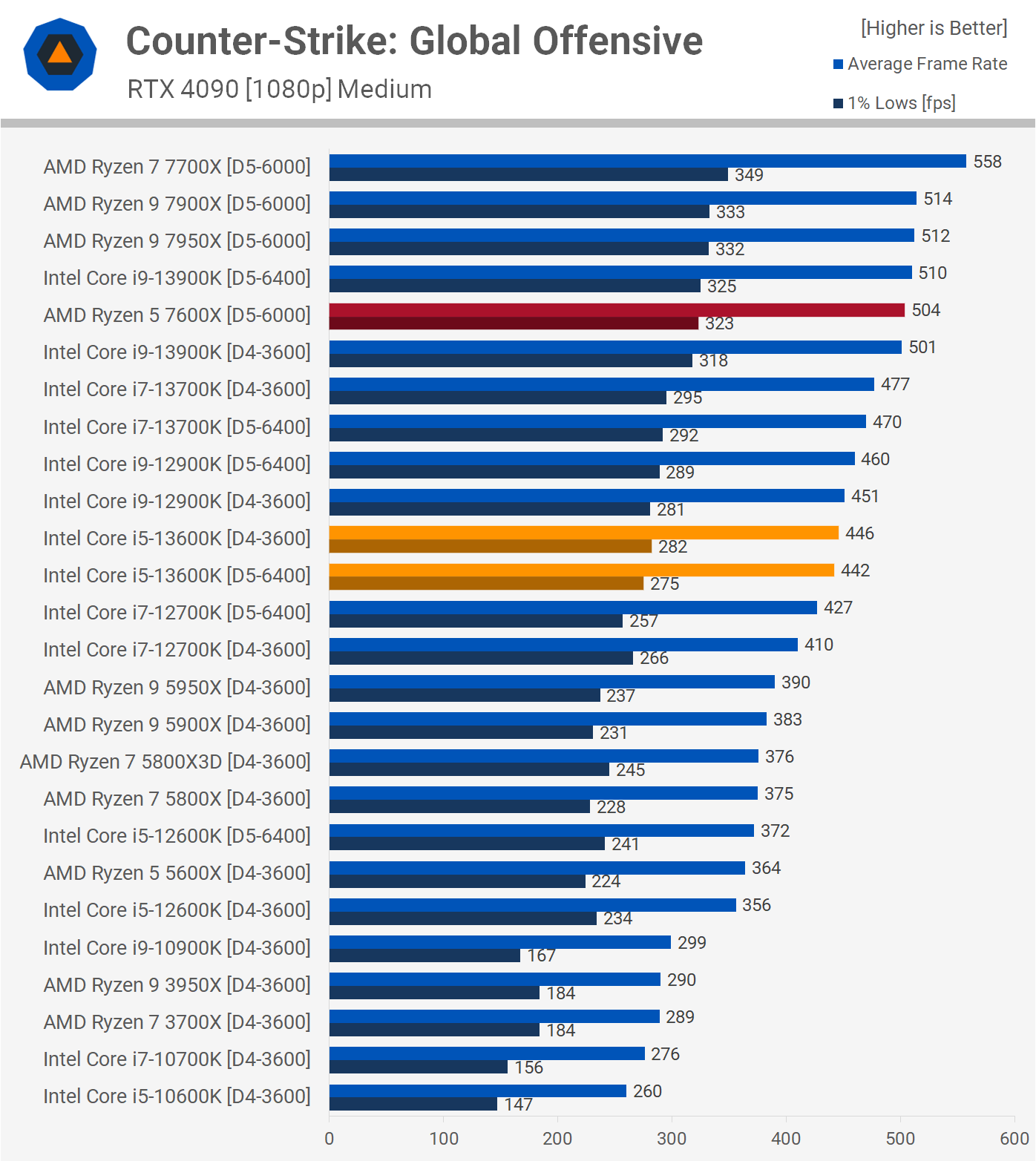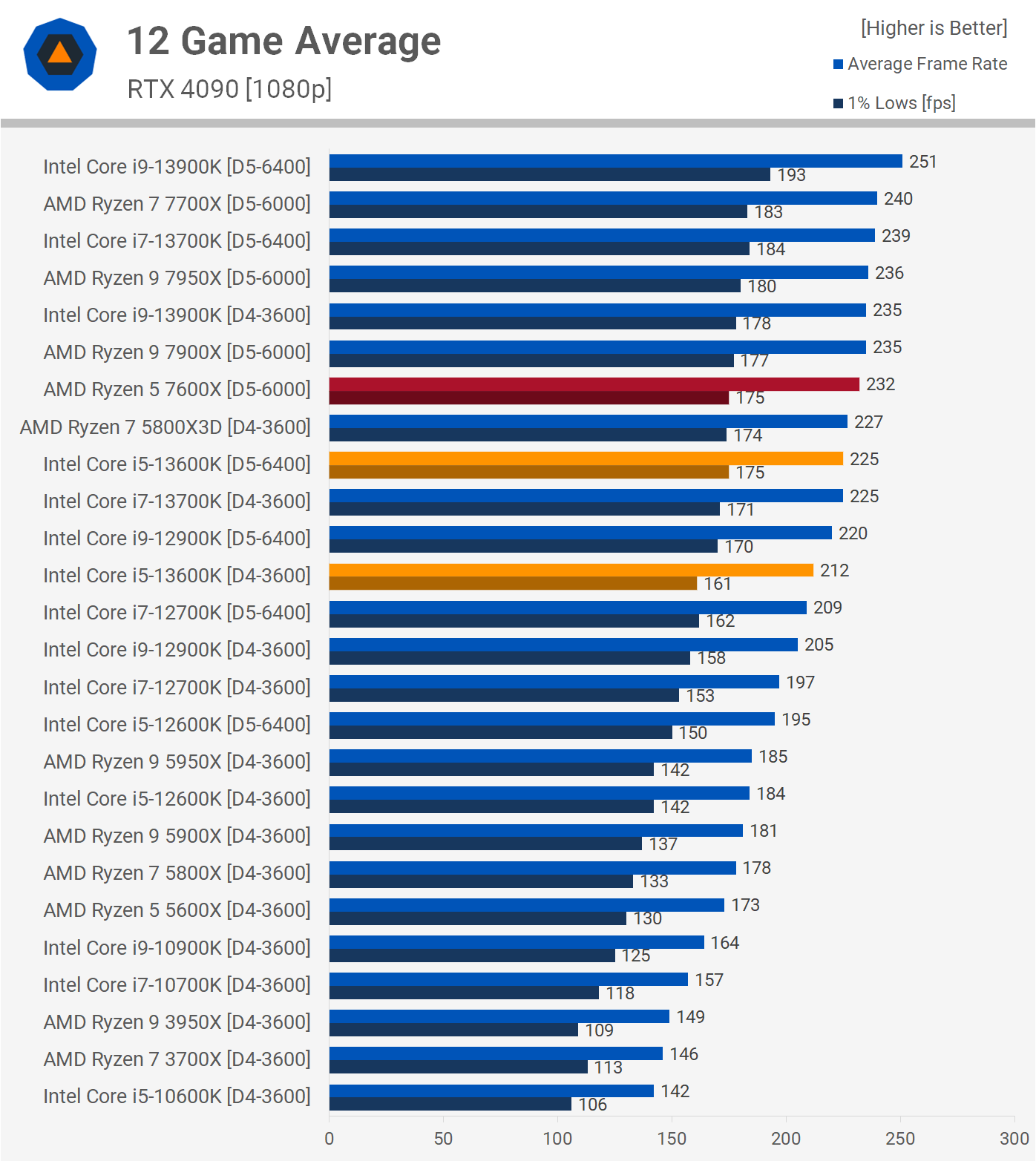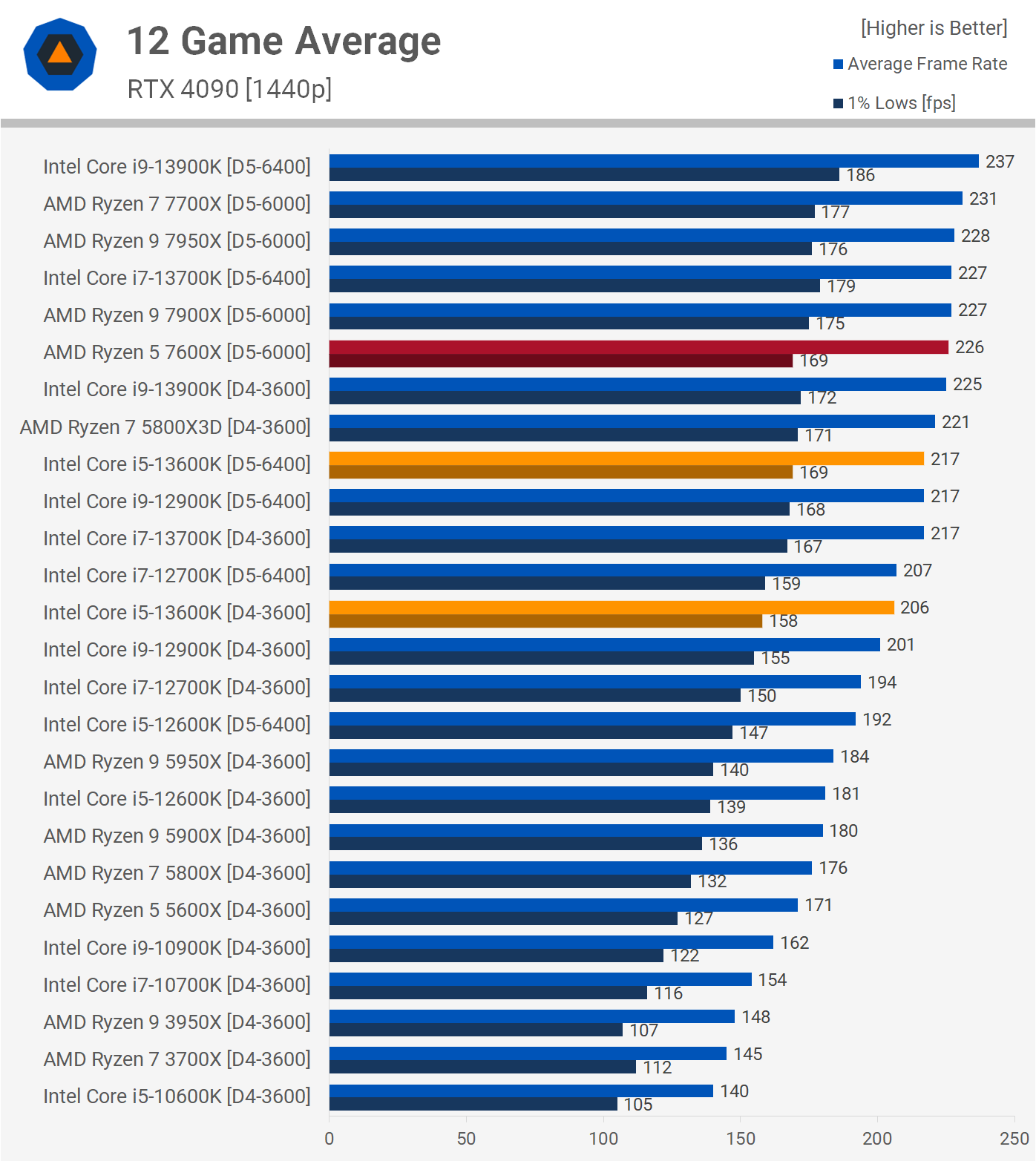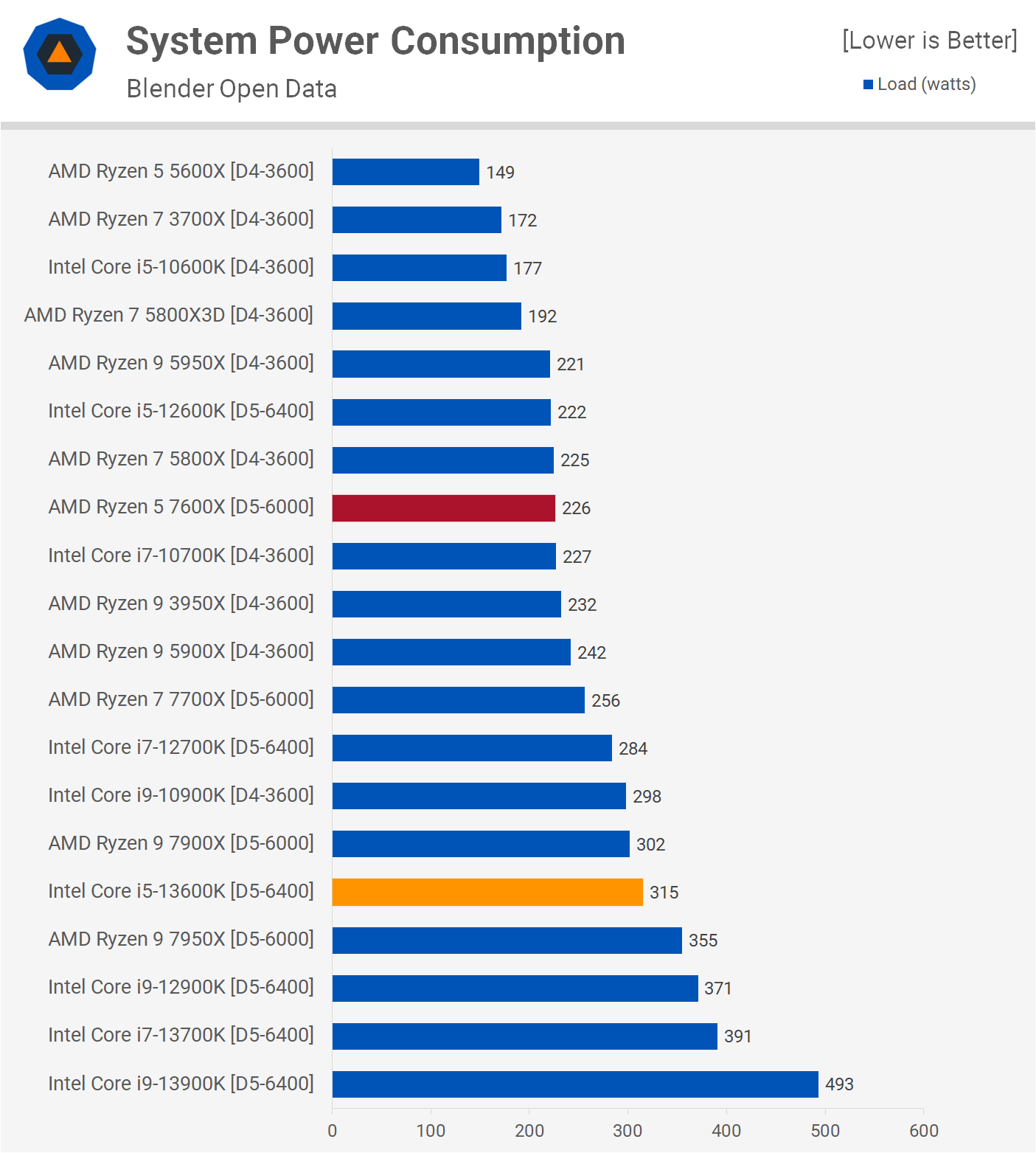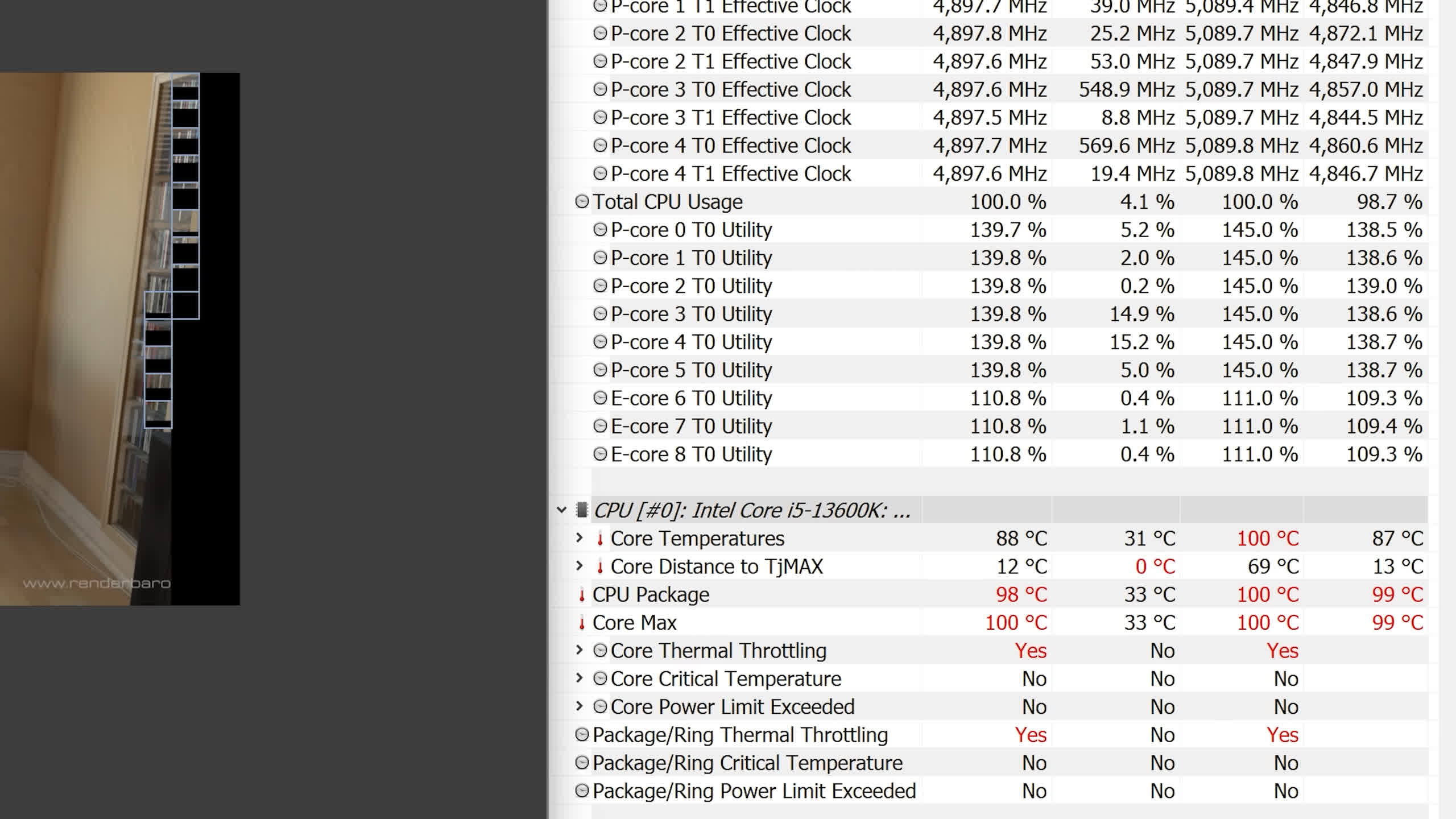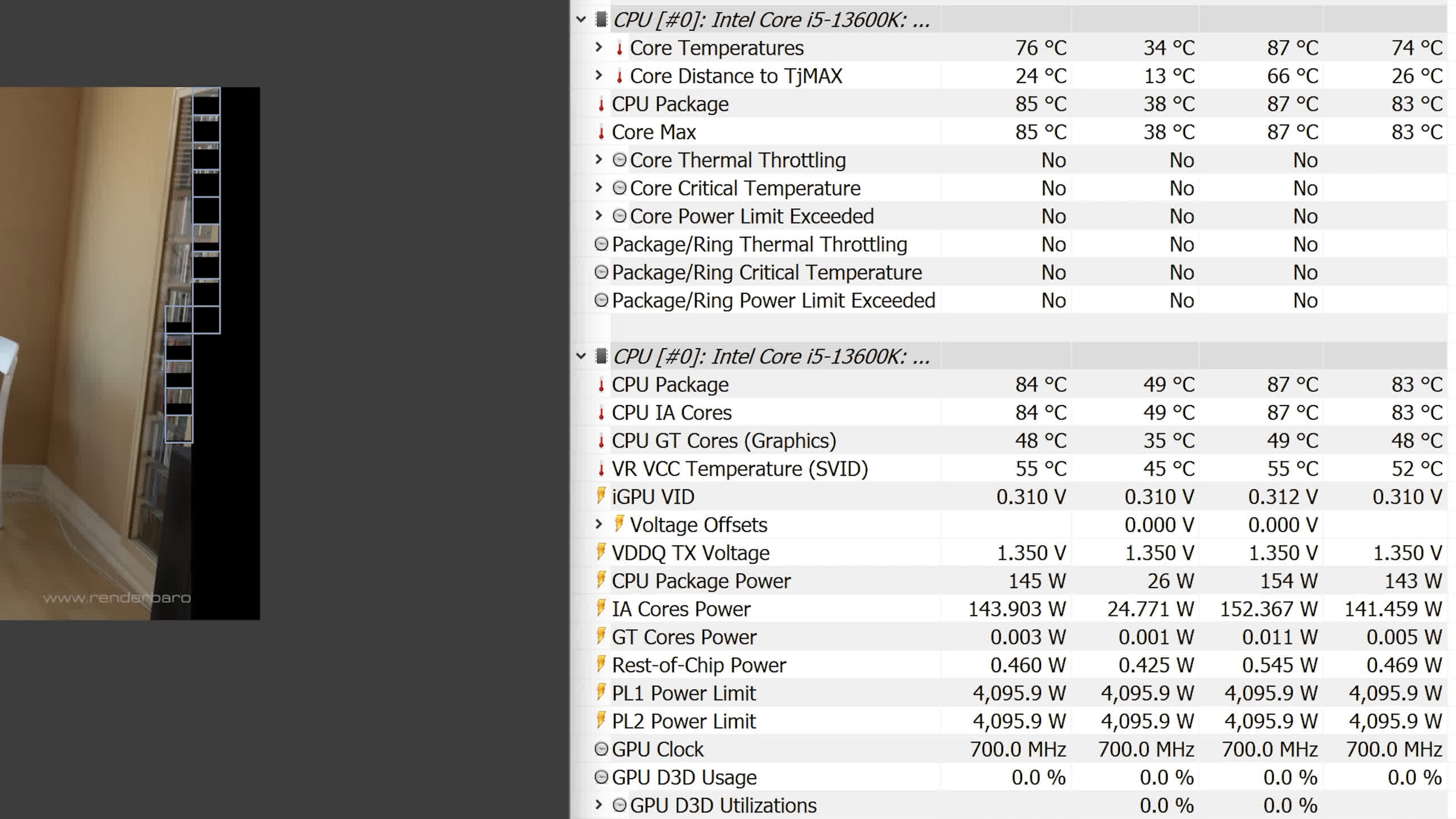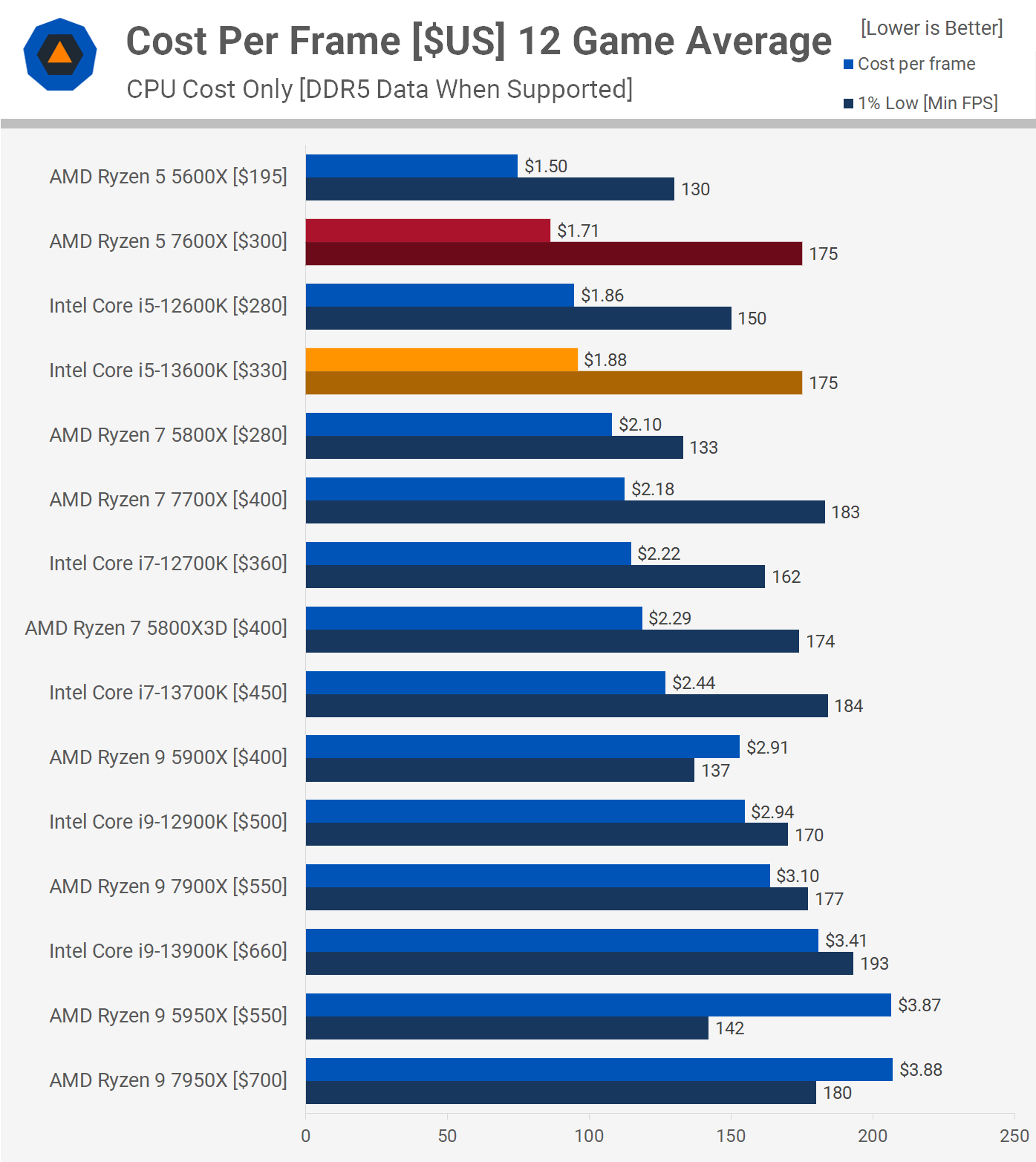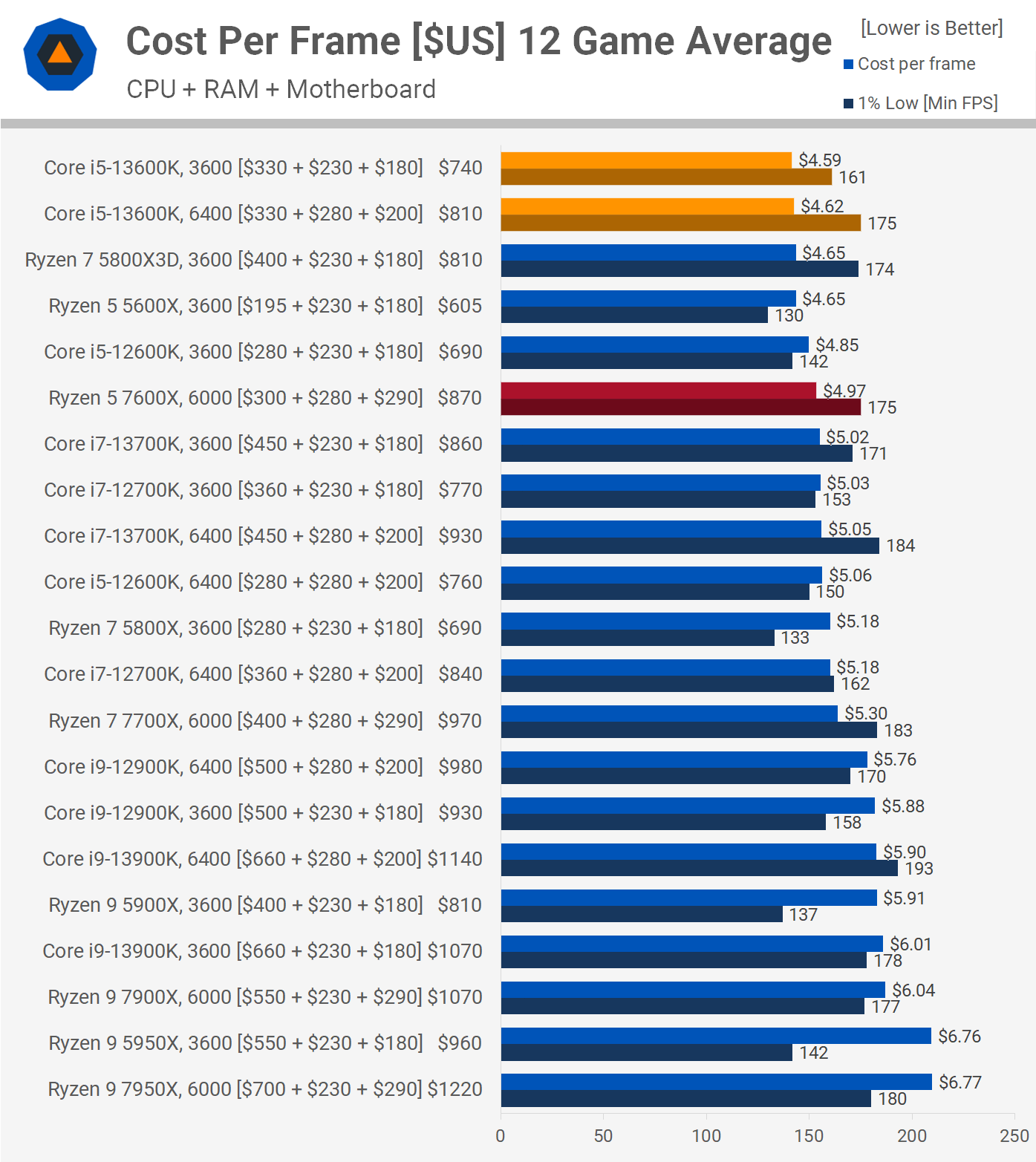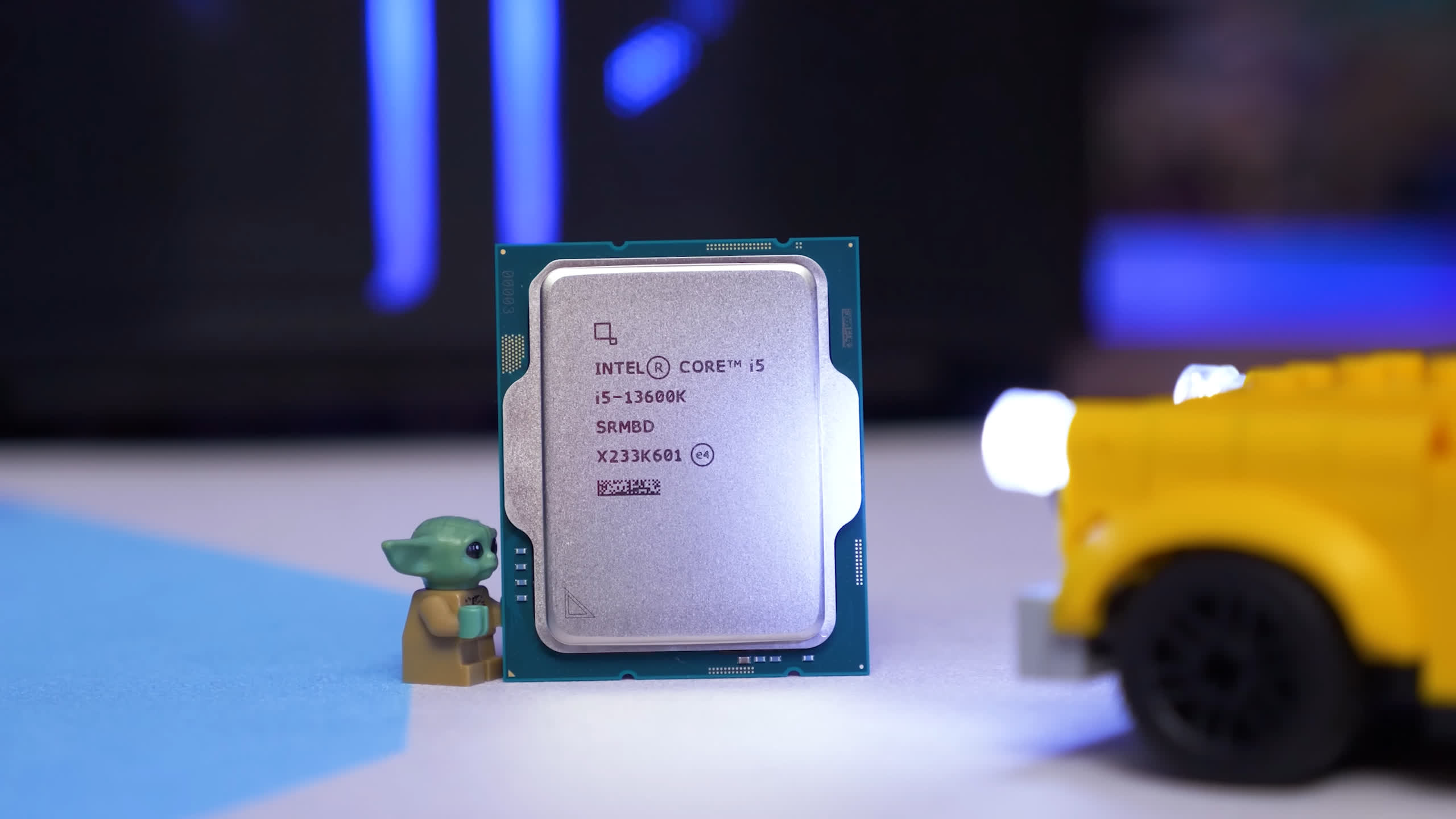The Core i5-13600K is the most affordable model in Intel's new Raptor Lake (K-SKU) range. We're very excited about the prospects of this CPU because the 12600K was a personal favorite of ours, so with the 13600K promising even better gaming performance, it should be a real winner.
Intel lists an MSRP of $330 (per 1,000 unit price) and we're happy to report that retailers have been able to list it for $330. That makes the Core i5-13600K just $30 more expensive than the Ryzen 5 7600X and $70 cheaper than the 5800X3D.
As for specifications, there are some noteworthy changes when compared to the 12600K. The P-cores have seen an increase in L2 cache capacity to 2 MB, while the E-cores see an even bigger upgrade, not only are there twice as many at 8, but the L2 cache has been upgraded from 2 MB per cluster to 4 MB for a total of 8 MB. Even the L3 cache capacity has seen a bump, going from 20 MB to 24 MB.
In total, the i5-13600K packs a massive 49% more cache than the 12600K. Not only that, but the peak core clock speed has also increased by 4% from 4.9 GHz to 5.1 GHz. Moreover, DDR5 memory support has been improved from DDR5-4800 with 12th-gen to DDR5-5600 for 13th-gen, though DDR4 sees the same 3200 support. There's also 16 lanes of PCI Express 5.0 and 4 lanes of PCIe 4.0 from the CPU.
As with previous reviews of Raptor Lake chips, a word about power limits, or lack thereof. It's important to note that although Intel claims a 181 watt max turbo power for the 13600K, that's not enforced (and by Intel's own guidance it's not meant to be enforced). This means all Z690 and Z790 boards run 12th and 13th-gen Core series processors without any power limits in place.
This has been an Intel issue for a long time and it's become an AMD issue as well. The Zen 4 CPUs ran far more efficiently when power limited, sacrificing only a small amount of performance for significantly lower power consumption which results in lower operating temperatures. But this isn't the out of the box performance as both AMD and Intel are gunning for top spot.
Anyway, we didn't power limit the AMD Zen 4 CPUs, so we're not going to for Intel either, rather we'll focus on showing you what the default behavior is for these chips.
For testing and benchmarking we have some Intel 10th-gen and 12th-gen Core processors including popular Core i5, i7 and i9 models for comparison in case you are planning to upgrade. All 12th and 13th-gen CPUs were tested using DDR4-3600 dual-rank CL14 memory and DDR5-6400 single-rank CL32 memory. All of this testing has been updated for this review, so all the gaming data is fresh.
From AMD we've also got a range of Zen 2 and Zen 3 CPUs tested using 32GB of DDR4-3600 CL14 dual-rank memory on the MSI MPG X570S Carbon Max WiFi motherboard running the latest BIOS. The Zen 4 AM5 test system is based on the MSI MEG X670E ACE using 32GB of DDR5-6000 CL30 memory, we have included all the Zen 4 CPUs released thus far.
All our CPU gaming data has been updated using the Nvidia GeForce RTX 4090, testing at 1080p and 1440p, so there's a lot to go over. Also please note we're using Windows 11 and resizable bar has been enabled for all configurations.
Clock Speeds
First, here's a look at the i5-13600K clock behavior in Cinebench R23. After an hour of load testing the 13600K maintained an all-core frequency of 4.9 GHz for the P-cores and 3.9GHz for the E-cores, this is down from 5.1 GHz for the P-core when the CPU is cool, so we still saw a 4% decline in performance due to thermal throttling.
On that note, this frequency was sustained using the MSI CoreLiquid S360 360mm liquid cooler installed inside the MSI Prospect 700R case.
Then for single core workloads, the 13600K appeared to maintain a clock frequency of 5.1 GHz underload, so the advertised frequency was achieved in this test.
Application Benchmarks
Starting with the Cinebench R23 multi-core results, we see that the 13600K is good for a score of roughly 24,000 pts after a 10 minute loop, making it a whopping 54% faster than the 7600X, an embarrassing margin there for AMD, and a quick indication that productivity is going to be a one-sided battle.
The single core performance of those P-cores is also very good as the 13600K managed to nudge ahead of the 12900K and 7700X, making it a few percent faster than the 7600X. This again suggests that best case the 7600X will only match the 13600K in productivity benchmarks, and even then this will be a rare occurrence.
Firing up the 7-Zip File Manager compression benchmark sees the 13600K easily dominating the 7600X, delivering 36% greater performance and that places it alongside the likes of the 5950X and 12700K, not bad for the new $330 processor, not bad at all.
The decompression results are more favorable for AMD, but even so the new Core i5 still easily defeats the 7600X by a convincing 20% margin and is only 7% slower than the 7700X.
Moving over to the Blender Open Data benchmark we find that the 13600K is almost 40% faster than the 7600X, completing this workload in just 625 seconds opposed to 862 seconds. Yet another comfortable win for Intel's new Core i5 processor.
It's even worse in Corona as the 13600K fairs even better in short burst workloads, here it was 51% faster than the 7600X, completing the task in just 61 seconds, making it slightly faster than the 12700K, and roughly on par with the Ryzen 9 5900X.
Even in Premiere Pro the 13600K led the 7600X, this time by an 11% margin and that saw it match the 5950X with a score of 1084 pts.
Here is a rare example of the 7600X outpacing the 13600K in a productivity workload, though performance overall was about the same with a small 4% difference in it. Both delivered 12700K-like performance, so needless to say both CPUs are very fast.
The 13600K jumped ahead of the After Effects benchmark, leading the 7600X by a reasonably slim 6% margin.
The last application benchmark we have for you looks at code compilation performance and here the 13600K is comfortably back out in front of the 7600X, winning this test by a 16% margin, coming in just behind the 5900X.
Gaming Benchmarks
Time for some gaming benchmarks and we'll start with Factorio as we've been doing as of late. Here the 13600K and 7600X are surprisingly close, but we guess that makes sense as the E-cores aren't particularly useful here. This allowed the 7600X to take the lead, albeit by a very slim margin.
Next up we have Watch Dogs: Legion at 1080p and please note we have recorded all the 1440p data, but rather than go over that here as it is quite similar to the 1080p results, we'll just show the 1440p average after we've gone over all the games individually.
Here we see that the 13600K is good for 163 fps on average using DDR5 memory or 137 fps with DDR4, making the DDR5 memory 19% faster which is a significant difference. This also means when using DDR5 the 13600K was 5% faster than the 7600X, not a huge margin but still a win for Intel here. The 13600K also wasn't much slower than the 7700X as it managed to match the previous generation flagship 12900K, so very impressive stuff.
In Rainbow Six Extraction DDR5 memory is of little benefit but even so the 7600X was 8% faster than the 13600K and a massive 21% faster when comparing 1% lows.
Still as disappointing as those margins are, the performance on offer from the 13600K is mighty, I doubt many will scoff at over 400 fps on average.
The 7600X also came out ahead in Hitman 3, though only by a slim margin, we're talking just 4%. So performance is much of a muchness in this title, and the 13600K was only 6% slower than the 13900K.
The 13600K did get the better of the 7600X in Far Cry 6, boosting 1% lows by 8% despite both delivering the same 180 fps on average. So again it won't matter which of these CPUs is used for playing this title.
The 13600K also edged out the 7600X in F1 22, boosting the average frame rate by 3% and the 1% lows by a much more significant 10%.
Of course, both CPUs delivered more than enough performance in this title, and it was impressive to see the 13600K matching the 12900K.
Despite the 13900K dominating in Spider-Man Remastered, the 13600K wasn't nearly as impressive with 118 fps on average, meaning it could only roughly match the 7600X, though truth be told it wasn't much slower than the 13700K, so overall a very good result.
The new Core i5 was a bit more dominant in Shadow of the Tomb Raider, and although it only knocked off the 7600X by a 4% margin when comparing the average frame rate, it was a much more convincing 12% faster when looking at the 1% lows.
The 13600K gets steamrolled in Horizon Zero Dawn by a 28% margin in favor of the 7600X, it's bizarre how well the Zen 4 CPUs perform in this game, it's certainly an outlier in our limited 12 game testing, but a strong result for AMD all the same.
The 13600K and 7600X were far more competitive in Cyberpunk 2077, basically delivering identical performance, making them comparable with the 7950X, 7900X, 7700X and 12900K.
The 7600X did outgun the 13600K by a slim margin in ACC, we're only talking about a 4% margin though so overall they're very similar. In short the 13600K was a fraction faster than the 12900K, and only slightly slower than the 13700K.
The 13600K wins The Riftbreaker benchmark when armed with DDR5 memory, beating the 7600X by a 6% margin with an average of 195 fps on average, making it just a fraction slower than the 7700X, 13700K and 13900K.
Finally, we have the CS:GO results and a bit like Horizon Zero Dawn this is a game where the 7600X easily beats the 13600K, though the margins aren't nearly as extreme at 13%.
The 13600K was slightly slower than the 12900K, but faster than the 12700K, so a good result when compared to the previous generation Core i7 and i9 parts.
12 Game Average
Here's our look at the gaming average at 1080p, and the Ryzen 5 7600X managed to come out on top, at least when comparing the average frame rate where it was a mere 3% faster. The 1% lows were identical at 175 fps though, and the takeaway should be that the overall gaming experience is virtually identical using either CPU.
The 13600K did drop off a little with the DDR4-3600 CL14 memory, but we're only talking about a mere 6% decline for the average frame rate and 8% for the 1% lows. Of course, at times the margins were significant, so it will depend on the games you play.
At 1440p we see similar results, where the R5 7600X was 4% faster when comparing the average frame rate, but not faster for the 1% lows.
In short, the 13600K was comparable to the 12900K and a bit faster than the 12700K, which is a very positive comparison for the new Core i5 processor.
Power Consumption
For all-core workloads, and similar to all other 13th-gen Core CPUs, the 13600K is a bit of a pig on power, pushing total system usage to 315 watts, which certainly isn't crazy, but it's also a little over 70 watts more than the 5900X for slightly less performance.
It's also slightly more than the 7900X despite the Zen 4 part being almost 90% faster. So power efficiency isn't good, but it's manageable and that's about the most positive thing you can say.
Cooling Performance
Using the MSI CoreLiquid S360 360mm liquid cooler, the Core i5-13600K peaked at TjMAX after less than a minute of all-core load, so 100c. That said, despite running extremely hot, this only reduced the all core frequency by 200 MHz, from 5.1 GHz at the start of our testing to 4.9 GHz once at TjMAX.
So while annoying, it doesn't have a significant impact on performance. Oddly this is slightly worse than the result we received with the 13700K and we should note that by default the 13600K ran at a sustained package power of 186 watts, with a peak package power of 200 watts.
If we load the 181 watt profile in the MSI BIOS, this reduces the PL1 and PL2 rating to 181 watts, though interesting the package power maxed out at 154w typically hovered about 145 watts for long duration testing.
This lowered the sustained P-core frequency from 4.9 GHz to 4.7 GHz, a 4% drop, and an 8% drop from the peak of 5.1 GHz when running without power limits. This lower power target did drop the peak operating temperature to 87c which is a nice improvement over stock and for those running a lot of all-core workloads this is a more optimal configuration in our opinion, but of course, you are leaving some performance on the table.
Cost vs. Performance
Moving on to cost per frame analysis, we'll start by comparing just the cost of the CPU. This gives the 7600X an advantage over the 13600K as it provides the same level of gaming performance, while costing $30 less.
But for a more accurate comparison we need to include platform costs, so let's do that...
Now when factoring in the cost of the memory and motherboard, things look different. The 13600K is clearly better value than the 7600X right now. With both running quality DDR5 memory, the Core i5 processor came in at a cost reduction of 7% per frame, which is a reasonable margin.
Perhaps more crucial is the fact that this made the 13600K the best value part on the market right now, muscling out the 5800X3D and 5600X.
As mentioned in the 13900K review, we're aware you can get much cheaper DDR4 memory, but it will also reduce performance, which kind of breaks the cost per frame analysis. We'd have to revisit parts like the 13600K and 5800X3D with sweet spot DDR4-3600 CL16 memory to see how they stack up.
What We Learned
As we expected, the Core i5-13600K is a much more practical and better value CPU than not just the 13900K, but also the 13700K, particularly when focusing on gaming.
At the high-end we feel strong arguments can be made for both Intel Raptor Lake and AMD Zen 4, but towards the mainstream segment it looks as though Intel is on a comfortable position over AMD.
Sure, the power consumption isn't great and without some power limiting the thermals are a bit ugly, but for gaming a 150w package power limit shouldn't have a big impact, realistically you should see similar results to what's shown in this review, if not the exact same results.
To be clear, the 7600X and 13600K are extremely evenly matched when it comes to performance, there's certainly no clear winner here. But the 13600K package is cheaper overall, largely thanks to the availability of already established Intel Z690 motherboards.
Although you can save even more money by opting for DDR4, and perhaps DDR4-3600 CL16 is the way to go there, sacrificing only a small amount of performance compared to what's been shown here, we are seeing more and more cases of modern games where DDR5 can make a difference.
So for those building a new system, paying the premium might be worth it in the long run, but either way you have the option of going DDR4 or DDR5 with the 13600K, making it a more flexible product.
Then there's productivity performance, where the 7600X gets steamrolled and this is a big problem for AMD. Even when limited to a package power of 150 watts, which reduces performance by around 7%, the 13600K outscored the 7600X by over 40% in Cinebench R23, and this power limit doesn't affect lightly threaded performance, just core-heavy workloads.
So no matter which way you slice it the 7600X gets embarrassed by the 13600K in productivity benchmarks, it's a complete reversal of what we saw just a few generations ago when AMD walloped Intel with their 16-core desktop parts up against 8 and 10 core models.
In our opinion, AMD is in a position where they have to discount the 7600X towards the $200 mark in order to compete in anything outside of gaming. Not only that, but AMD needs quality sub-$200 AM5 motherboards for the 7600X to make sense even if the CPU is discounted.
As enticing as the AM5 platform is, if we were building a new PC today, for either gaming or work, we'd be going with the Core i5-13600K, it's the obvious choice, just as the 12600K was when we reviewed it back in late 2021.
